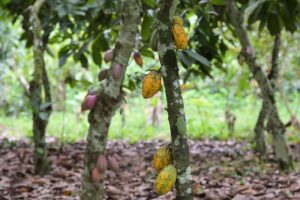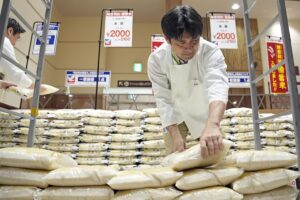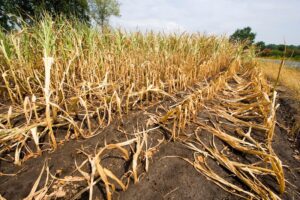
Photo by Suzy Hazelwood from Pexels
Episode 96: Crafting Compelling Personal Climate Change Stories
In this month’s Citizens’ Climate Radio episode, host Peterson Toscano and the CCR teams introduce a fresh approach to climate change storytelling by exploring personal stories as metaphors. While these stories are not explicitly about climate change, they reveal truths and perspectives that resonate with our climate work. Join us to discover how personal narratives can enhance and diversify our stories about climate change. You will also learn expert storytelling tips to apply when telling stories about climate change.
Using Personal Stories as Metaphors
Peterson challenges us to use personal stories, which hold significant meaning and energy for us, as metaphors for climate change. These stories, often about transitions, conflicts, or breakthroughs in our lives, can draw powerful parallels to our climate efforts. You’ll hear two compelling stories from the Citizens’ Climate Radio team members Erica Valdez and Horace Mo, each reflecting personal growth and resilience.
Horace’s Story: A Journey of Friendship and Belonging
 Horace Mo shares his experience of moving from China to the USA as a 16-year-old. Navigating a new culture and language, Horace found support and friendship in his roommate Kai, who helped him overcome language barriers and cultural differences. This story of adaptation and support mirrors the collective effort needed in climate work, emphasizing the importance of community and mutual aid. Horace reflects, “My English ability soared like a rocket with the help of Kai and other students at school. For the first time, I sensed a personal belonging to the school community.”
Horace Mo shares his experience of moving from China to the USA as a 16-year-old. Navigating a new culture and language, Horace found support and friendship in his roommate Kai, who helped him overcome language barriers and cultural differences. This story of adaptation and support mirrors the collective effort needed in climate work, emphasizing the importance of community and mutual aid. Horace reflects, “My English ability soared like a rocket with the help of Kai and other students at school. For the first time, I sensed a personal belonging to the school community.”
Erica’s Story: Confronting Hidden Challenges
 Erica Valdez recounts her high school friend Sophia’s (not her real name) struggles with college applications due to her parents’ undocumented status. Erica’s story highlights the hidden challenges marginalized communities face, drawing a parallel to the often-overlooked impacts of climate change on vulnerable populations. It emphasizes the need for empathy and support in both personal and climate-related contexts. Erica notes, “Witnessing her stress made me ask, how many people are going through something similar?”
Erica Valdez recounts her high school friend Sophia’s (not her real name) struggles with college applications due to her parents’ undocumented status. Erica’s story highlights the hidden challenges marginalized communities face, drawing a parallel to the often-overlooked impacts of climate change on vulnerable populations. It emphasizes the need for empathy and support in both personal and climate-related contexts. Erica notes, “Witnessing her stress made me ask, how many people are going through something similar?”
Making Climate Connections
Peterson tells a story about a toxic, abusive relationship and reveals how this personal relationship mirrors society’s relationship with fossil fuels. He also encourages listeners to see the climate connections in Horace’s and Erica’s stories. Both narratives reflect themes of fear, support, and overcoming obstacles—common experiences in the climate movement. We can create more relatable and engaging narratives that resonate with diverse audiences by relating personal stories to climate issues. Peterson emphasizes,
We need stories that reveal the power of climate change solutions. We need stories that unveil the driving force behind our efforts in addressing climate change. We need stories that unveil the driving force behind our efforts in addressing climate change. Stores that unearth how climate change affects some people differently than others. Stories that will inspire us to keep going.
Nerd Corner: The Economic Impact of Climate Change
 In the Nerd Corner, Citizens’ Climate Research Coordinator Dana Nuccitelli discusses the economic impacts of climate change. Using lizards as an analogy, Dana explains how extreme weather events and shifting climates can stunt economic growth, emphasizing the urgent need for swift climate action to mitigate these effects. Dana states, “Most economists agree the faster we act on climate change, the better it will be for the economy. That’s especially true if we use a market-based solution like putting a price on carbon pollution. That way, we can see the true price of products, including their climate costs, like a chameleon turning off its camouflage.”
In the Nerd Corner, Citizens’ Climate Research Coordinator Dana Nuccitelli discusses the economic impacts of climate change. Using lizards as an analogy, Dana explains how extreme weather events and shifting climates can stunt economic growth, emphasizing the urgent need for swift climate action to mitigate these effects. Dana states, “Most economists agree the faster we act on climate change, the better it will be for the economy. That’s especially true if we use a market-based solution like putting a price on carbon pollution. That way, we can see the true price of products, including their climate costs, like a chameleon turning off its camouflage.”
Listen Now
Why Climate? Featuring James Earl Hollywood III
In the new segment, Why Climate?, volunteer James Earl Hollywood III shares his motivation for climate action. A father of nine from Maryland, James highlights how environmental degradation disproportionately affects marginalized communities and underscores the importance of inclusive and collaborative climate solutions. James shares, “Climate change is not just an environmental issue; it’s a human rights issue that affects every aspect of my life.”
 About James
About James
James Earl Hollywood III is a dedicated husband, father of nine, minister, and author with a deep commitment to social change and community empowerment. He is pursuing a doctorate in Social Leadership, combining his extensive academic background in Criminology, Public Administration, Communications, and Implementation Science with his passion for advocacy and leadership.
James has been actively involved with organizations such as the Citizens’ Climate Lobby, Americans for Prosperity, and various advisory groups, leveraging his expertise to drive meaningful change. Known for his dynamic leadership and ability to inspire others, James continues to make a positive impact through his work, striving to create a better, more equitable future for all.
If you want to share with us why you work on climate change, let us know. Contact details below.
Good News: CCL’s Successful Climate Conversations Campaign
 Tamara Staton, CCL’s Education and Resilience Coordinator, reports on the success of CCL’s recent campaign, which sparked over 27,000 climate conversations across all 50 states. This grassroots effort demonstrates the power of personal engagement in driving climate action and raising awareness. Tamara concludes, “Each conversation is a step towards greater awareness and collective action.” Read more about how CCL volunteers are breaking the silence around climate change. Find out about other actions and monthly campaigns by visiting CCLUSA.org/action.
Tamara Staton, CCL’s Education and Resilience Coordinator, reports on the success of CCL’s recent campaign, which sparked over 27,000 climate conversations across all 50 states. This grassroots effort demonstrates the power of personal engagement in driving climate action and raising awareness. Tamara concludes, “Each conversation is a step towards greater awareness and collective action.” Read more about how CCL volunteers are breaking the silence around climate change. Find out about other actions and monthly campaigns by visiting CCLUSA.org/action.
Stay Connected and Share Your Story
Peterson invites listeners to share their personal stories and how they connect to climate change. Whether through social media, public speaking, or personal conversations, sharing these narratives can inspire and motivate others in the climate movement. Consider submitting your story to Citizens Climate Radio. See contact details below.
Listener Survey
We want to hear your feedback about this episode. Please fill out our short survey.
Join the Conversation
Engage with other listeners and share your thoughts on our social media channels. Follow and connect with us on X, Instagram, LinkedIn, Facebook, and TikTok.
Tune in next month for more inspiring stories, expert insights, and actionable climate solutions. Together, we can make a difference, one story at a time.
We Want to Hear from You
- Email: radio @ citizensclimate.org
- Text/Voicemail: 619-512-9646 (+1 if calling from outside the USA.)
Shoutouts to the following people and groups for the ways they promote us through social media: On X (FKA Twitter): Michael Cooper, the Arkansas chapter of CCl, Frances Stewart, M.D, Robert D. Evans, Bill Nash, Jane Haigh, 1.5, CCL Alameda, CCL Bellevue, Washington, and Jean Lloyd Larson. On TikTok: Linda Jay Reed, JackAsh007, Jan Cleveringa, Climate Countdown, The Green Journey, and Dr. Dana R. Fisher.
Next Month
Dr. Dana R. Fisher wrote Saving Ourselves: From Climate Shocks to Climate Action. She will tell us about her book and read from it. We will also include students from Bucknell University who created soundscapes of how they feel about climate change. Plus, there are new installments of the CCL Youth Corner, the Resilience Corner, and our latest feature, Why Climate?
Production Team:
- Written and produced by Peterson Toscano, Horace Mo, Erica Valdez, Dana Nuccitelli, and Tamara Staton.
- Technical Support: Ricky Bradley and Brett Cease
- Social Media Assistance: Flannery Winchester
Music is provided by epidemicsound.com
Transcript Ep. 97 Crafting Compelling Personal Climate Change Stories
SPEAKERS
Horace Mo, Peterson Toscano, Dana Nuccitelli, Tamara Staton, Erica Valdez, James Earl Hollywood III
Peterson Toscano 00:00
Welcome to Citizens Climate Radio your climate change podcast. In this show, we highlight people’s stories, we celebrate your successes, and together we share strategies for talking about climate change. I’m your host Peterson Toscano Welcome to Episode 97 of Citizens Climate Radio, a project of Citizens Climate Education. This episode is airing on Friday, July 26 2024. In the nerd corner, Dana Nuccitelli. Through the help of some lizards, reveals the costs associated with climate change. Tamaris Staton shares good news about over 20,000 Climate conversations in one month. We also premiere a new segment to the show, Why Climate. A father of nine tells us why climate change is the issue he has dedicated his free time to addressing.
Peterson Toscano 00:54
But first, we are taking a deep dive into a new type of climate change storytelling, one that may revolutionize the types of stories you tell. Today, we are going to explore personal stories as metaphors. These stories have energy behind them because they’re meaningful to us. But they’re not explicitly climate change stories. Instead, they could reveal a truth or a perspective that we can relate to some aspect of our climate change work. You will hear three different stories. Two of these come from CCR team members Eriic Valdez and Horace Mo. I gave them each the following assignment.
Peterson Toscano 01:43
Share a meaningful story from your life and experience. But do not write specifically about climate change, the environment, or nature. Consider moments of transitions in your life. conflicts or breakthroughs. Include specific details about people places, things and settings. Express your emotions and share your feelings in different parts of the story. The assignment is essential for helping us craft compelling stories that capture and retain the listener’s attention.
Peterson Toscano 02:19
Erica and Horace both recently graduated from college, and they chose stories from their time as high school students. They wrote their first drafts and shared them with me, and I gave them lots of feedback. In both cases, they needed to add more details about the people in the story. They also needed to add emotion. Their stories had endings, but these needed to be strengthened. Storytelling is a craft. It requires humility and patience so that we can receive feedback. A first draft may be good, but it must be much better.
Peterson Toscano 02:54
My husband is a professional writer and teaches creative writing at a university. Even as an award-winning author, he recognizes that his first draft is incomplete. He shares his writing with me and with his writing friends, he listens to our feedback, makes changes, and works on it to make it better and better. This work is crucial, and you will be rewarded for your hard work. First, let’s hear Horace’s story. Horace added music and sound effects to make it pop. But listen for the details he includes and the emotions he references. Also, be aware of the feelings his story stirs up for you.
Horace Mo 03:34
A 16-year-old boy carried two black 50-pound suitcases alone and flew across the Pacific Ocean from China to the USA. It was the boy’s first overseas trip and he landed in an old boys boarding school in Salzburg, Pennsylvania. While the boy was excited about the new educational opportunities awaiting him, he was concerned about assimilating into a completely unfamiliar living environment. Even worse, he could barely speak fluent English. At that point, he was ill-informed about American culture. That boy was me.
Horace Mo 04:11
While facing the uncertainty and being far from home as a teenager, I was fortunate to meet my first year roommate Kai, a Black 16 year old from San Francisco who is devoted to soccer and always possesses contagious and joyful giggles I didn’t know it then but Kai would become one of my best lifetime friends.
Horace Mo 04:30
The first several months of school were tough for me. I had a hard time fully comprehending class lessons due to my limited English. For a similar reason, I could not easily converse with my peers. I sometimes felt extremely discouraged when I saw pure confusion on their faces, and they could not grasp my true intention in my broken English phrases. Luckily, my school teachers and classmates were lenient with me and passionate about helping me out. Kai, however, was one of the first people who volunteered to help me with my English learning he waited patiently for at least several seconds, and through me, I encouraging look whenever I stumbled over words or failed to find the right English word or expression. He also played a crucial role in adjusting my English pronunciation and grammatical usage. Although jokingly named my English-speaking Morse Code since it was often hard for him to understand to the full extent. He was always welcoming and friendly whenever I needed help with English. Not surprisingly, my English abilities soared like a rocket with the help of Kai, teachers, and many other students at school.
Horace Mo 05:34
I am grateful for their help and kindness. For the first time, I sensed a personal belonging to the school community. Not only did Kai help me with my basic English learning, but he also invited me to stay with his family in San Francisco for the Christmas break. We trekked the landmark hilly roads, saw the Apple headquarters, and walked across the Golden Gate Bridge. He also introduced me to some of his friends, who greeted me with excitement and warmth. Kai’s family also show me superior hospitality. Kai’s mom, Miss Natalie, told me about the origins of Christmas in local traditions in San Francisco. She took me out to local restaurants to try Polish and Vietnamese food. Mr. Natalie always assured me a safe and comfortable stay at their place. Throughout the trip with Kai in San Francisco, I felt cared for, loved, and valued, similar to how I would feel back in my original home with my parents in China.
Horace Mo 06:26
I am grateful that I met Kai in high school. It was a period of personal growth and friendship I could never have imagined before I started my academic journey in the US. He supported in helping me with English and his passion for taking me to his hometown gave me a sense of belonging and joy why I needed help most.
Horace Mo 06:45
In return, I invited her to go to China with me over the spring break during our senior year at high school. I was proud to showcase my hometown, the city of Chongqing, which is the origin of delicious meal called hotpot. Within the city we witnessed the magnificent view of the cityscape on the top of the highest local mountain, visited a Buddhist nunnery and experienced the art of Chinese calligraphy at home. While Kai stay in Chongqing was sure he was impressed by his engagement with the cultural and entertaining activities in Chongqing. His traveling widened his understanding of China and tightened the friendship bond between him and me. I’m sure my story with Kai will continue throughout our lifetime, as he’s a true friend, a teacher and a brother from another mother to me.
Peterson Toscano 07:32
And you may be thinking, great story. But what on earth does this have to do with climate change? On the surface, nothing at all, though as a metaphor, it touches on themes and feelings familiar to those of us doing climate work, Horace entered a new world and felt fear. He couldn’t succeed alone. So he developed meaningful relationships as he navigated this new world.
Peterson Toscano 08:02
Now, let’s listen to Erica story. Again, pay attention to the details She includes and the feelings you experience listening to her story. After she’s done, we’ll unpack both stories to see the climate connections.
Erica Valdez 08:18
Throughout high school, I couldn’t wait to graduate and move on to the next step: college. I was fortunate enough to have very supportive parents who encouraged higher education as a path for me and my siblings.
Erica Valdez 08:30
When it came time to apply for schools, I had a friend who didn’t know much about the process. I won’t use her real name today for privacy purposes. So we’ll call her Sophia. Picture this: we were high school seniors ready for this exciting next step. Sophia and I were close friends, we were on multiple sports teams together and shared classes. So we spent a lot of the day with each other. Sophia was outgoing, always bubbly and chatting away in our friend circle and during practices.
Erica Valdez 08:59
Our senior year, we took time in our classes to learn about school options in California and how to apply for them. Sophia asked me questions like, How do I know what school I’m applying for? What’s the California State system? And do we really need to pay for each application? I thought these questions seemed obvious. Hasn’t she talked about this before? When she asked these questions aloud, people laughed and expected her to find the answers herself. I could tell she was very stressed out about the process. I mean, I was stressed too, because this was a very big step in our lives.
Erica Valdez 09:28
But it came to a point where she stopped asking questions. She stopped talking to me about her applications. As deadlines approached, Sophia finally told me what was wrong. She was having trouble with school applications because although she was a citizen of the United States, her parents were undocumented. This prompted questions that I hadn’t thought of before. What does this mean? What issues does this cause? I learned that that this made it difficult to fill out general parent information, financial aid forms, and most importantly, her parents weren’t able to support her because they just weren’t familiar with college applications. I had just stepped into uncharted territory.
Erica Valdez 10:04
At first, I thought most of my friends are Hispanic, I’m Hispanic, we make up the majority of that school. Surely I can support my friend through this. Even surrounded by this community, a community where immigration is so common, I realized I had never had a conversation about it. I had never thought about someone so close to me dealing with these issues of immigration. And I had never been in a situation in which I tried to support them through it.
Erica Valdez 10:31
Back in 2019, people didn’t openly talk to others about their immigration status. There was a fear that didn’t need to be verbalized. It’s a fear that stopped my friend from seeking help and a fear that even stopped me from talking to my parents about it. That day, I realized how ignorant I was to issues that I didn’t face. Although I was surrounded by countless people who are probably going through something similar. I was never exposed to conversations about it. I did my best to support Sophia as a friend; I would answer the questions that I could, try to walk her through the application steps, and encourage her to seek advice. But I didn’t understand the magnitude of the situation. Witnessing her stress made me ask, “How many people are going through something similar?
Peterson Toscano 11:16
Are you hearing any themes that remind you of your climate work? I heard the challenge of talking about a topic that many people want to avoid, a topic that is both personal and political. Like Horace, Erica was faced with something new, something she didn’t know a lot about. The next step I had Erica and Horace take was to talk to each other about their stories. I asked them how they might pivot their stories to a climate-related issue or theme. Doing so will expand the types of climate change stories we tell. This goes beyond trying to convince others that climate change is real or serious. People need to hear all kinds of stories related to climate change. Because it is a multifaceted topic that intersects with so many other issues, here’s their conversation.
Erica Valdez 12:14
When talking about this problem that I had when I was younger, I had no idea that it would relate to issues about climate change. And the more I talked about it, the more I realized, wow, this has a lot of common themes. One of those things is that climate change is like immigration, such a silent topic. I mean, we’re so scared to talk about climate change. This could relate to climate change because people without documentation are so fearful of talking about it that it just goes unsaid. And it’s a very hush topic, like climate change.
Horace Mo 12:43
Yeah, I totally agree with you. And I do think that’s a really solid point that people who do not have legal documentation status in the United States will definitely feel more afraid of asking for help or asking for assistance from the government because they may fear, the risk of getting deported, of getting exposed about their illegal status. This will be especially vulnerable for people who are undergoing climate crisis right now, you know, after severe flooding or forest fire events, people who are sharing this illegal status in the United States, they might be going through some obstacles that we could never ever imagined.
Erica Valdez 13:30
Yeah, and I actually had when I was younger, a couple of experiences where I had to evacuate because of wildfires right in my backyard, basically. Talking about this story, I realized that Sophia probably would not have had the opportunity to evacuate and ask for help from people around her, from the government, or from her insurance. I mean, there would just be so many issues that would come from being from parents who are undocumented and having family members who had that fear, and they wouldn’t be able to ask for the same things that I was able to ask for.
Horace Mo 13:59
Yeah. So speaking of fear, in my story, I also talk about the fear of being unfamiliar with a new environment, especially why just arriving in the United States as a non-native English speaker, that fear, unlike the fear that you mentioned in the story, my fear of unfamiliarity also brings me that sense of anxiety and uncertainty about people or strangers that have never met before. But I do think there’s a common or a shared element between these two different types of fear that it drives people to be curious about the issue, especially for people who are observing this or for people who have already recognized this issue in society and for people who are undergoing this kind of fear, anxiety and uncertainty, will inspire them to talk about those issues to other people that they will trust and this could be a good way for them to relieve their stress.
Erica Valdez 14:56
There is also this fear of needing to know everything about a topic before you start talking about it or before you ask questions about it. And I see this a lot in the people around me when we talk about climate change. They think that because they’re not experts they can’t really ask questions or talk about it or have an opinion on it even. And we see this a lot in our personal stories. I mean, if we’re not educated on a subject to full capacity, you know, we feel like we can’t really talk about it. But that’s not the case, we should be encouraging each other to be curious, like you’re saying, and ask questions and ask for help because we need the support in all these issues.
Horace Mo 15:30
On top of that, just being able to open up and be able to seek for assistance, even though it could be much more difficult for people without the legal documentation. But I do think their own positions out there, like CCL or Sierra Club, which are doing a great job in society to uncover those underrepresented communities in the United States, and also just offering generous help to the more vulnerable communities. Like the people you mentioned in your story. Furthermore, I think there’s that benefit of getting to know new people just like me. When I first arrived at the school, I wasn’t expecting to make close friends like Kai, but you know, throughout the process, you might miss somebody that you strike a chord with that you just appreciate so much. Those people that you could meet on this new path to join the climate campaign couldn’t become your new friends. Not only you will learn a lot from them, but also those people will learn so many new things about you.
Erica Valdez 16:32
It’s super important. I mean, you never know what other people are going through. I think your story is super inspiring, for being in a new place and being able to ask for that help.
Horace Mo 16:41
So, listeners, here are the ways that you can connect your personal stories to a climate issue or to climate action. There are so many more examples that you can find in your daily life. And hopefully, those personal stories would help you stay motivated in your climate work or just prompt you to make a further step or whatever that you would do to protect our environment and convince more people to join our sideline.
Erica Valdez 17:09
It’s super important to find different ways to motivate ourselves through our climate work in taking personal stories like this that may seem like hardships or obstacles to inspire us is definitely an important way to do this.
Horace Mo 17:21
Yes, because there’s always a way to find help. And there are always organizations or entities out there to offer you to help. Stay connected.
Peterson Toscano 17:33
Horace and Erica, thank you so much for sharing your stories and making these connections for us. I’m in awe of the two of you. Seriously, when you collaborated on this episode, you were physically very far apart from each other. So ,well done. You see Horace is based in China and Erica is on the West Coast. What’s that 15 hour time difference? Amazing.
Peterson Toscano 17:57
In a moment, I will tell you one more story and connect it to climate change. To summarize, though, we need a variety of climate change related stories that cover the multitude of human experiences. Yes, we need stories that will help people take the threat of global warming seriously, but we also need stories that reveal the power of climate change solutions. We must share stories that unveil the driving force behind our efforts in addressing climate change. Stories that will inspire us to keep going. Stories that unearth how climate change affects some people differently than others. This takes hard work imagination and collaboration. Like Erica and Horace, find someone who will listen to your story and give you feedback so you can improve it, workshop the story and tinker with it. Struggled to find the connections and most likely you will.
Peterson Toscano 18:56
Here are three final points I want to impress upon you. Number one, when trying to make climate connections, not every story will work and some will work better than others.
Peterson Toscano 19:01
Number two, some stories are too personal to share. Not all of our stories are meant for the general public. They may be too revealing or intimate to share if you feel uncomfortable telling a personal story because it’s too personal. Respect that feeling. It may be the story you only share with a loved one.
Peterson Toscano 19:31
And number three, tell your own story, not someone else’s. At first, Erica wasn’t sure how to tell her story because it didn’t feel like it was hers. It was about her friend. After the first draft, though, we gave her feedback to help her talk about her part of the story, her feelings, and the challenges she faced. If your story includes someone else, ask yourself, “What is my part of the story to tell?”
Peterson Toscano 20:00
With that said, I’m about to break my own rule. I have a story a friend shared at a climate storytelling workshop I led. She is unavailable to tell it herself for this episode, but she said she would love for me to share it with her blessing, especially if it would help people better understand the concept of connecting personal stories to climate change. This is Tabitha’s story I share with her consent.
Peterson Toscano 20:36
Tabitha grew up in Southern California but then moved to Las Vegas, Nevada, and lived with her boyfriend. At first, things were going well; they both had jobs, and they enjoyed each other’s company. But over time, the relationship got tense; the boyfriend became more and more demanding. In fact, Tabitha realized she was in the middle of an abusive relationship. Although he never physically harmed her, there was a lot of mental and emotional abuse. As her life became more and more enmeshed with the boyfriend and she became more and more estranged from her own family in California, she decided she needed to move out. She needed to go back home to Southern California. But how? Her whole life was tangled up with this man, their finances, their home, their friends. Iit would be starting all over from scratch.
Peterson Toscano 21:36
One day, she had the courage to pack up a few things and take off while her boyfriend was at work. As she drove West, with the mountains ahead of her, she began to immediately have doubts. “This is too big of a change. How am I going to do something completely new? How am I going to make money? How is this going to work?” She began to waver. And as she did, suddenly, there was an unexpected downpour of rain. It rained so hard. She had to pull over.
Peterson Toscano 22:21
It was in the midst of that rainstorm, that she heard her own voice speaking to herself. “Just keep going. Just get over the mountain, then keep going.” And she did. She got over that mountain. She got back to Southern California. Her family helped her put her life back together. And now she is married with a lovely man who respects her and her intellect and her creativity and they have a beautiful son together.
Peterson Toscano 23:14
Now, what on earth does that have to do with climate change? I asked Tabitha. I was like, “Okay, this is a beautiful story. It’s powerful. It’s personal. It’s it’s meaningful. But But what does have to do with climate change?” Tabitha said, “Well think about it. We are in this deep relationship with fossil fuels. It started out well as a society, fossil fuels helped us and things seem to be going well, but we became more and more dependent upon them. And over time, it’s become a toxic relationship, quite literally in that there are toxins in the air that are making us sick.” She said, “Like the relationship I was in, that toxic abusive relationship, I needed to break free. We need to break free from our dependence on fossil fuels. But it’s so hard because everything is entwined. You just can’t walk away. It’s in every aspect of our lives. But that’s not an excuse to just sit in a toxic, abusive relationship. We need to keep going. We need to get over the hurdles that are ahead of us and keep going.”
Peterson Toscano 24:27
I love that story. And I thank Tabitha for giving me permission to share it with you.
Peterson Toscano 24:33
Once we have fully crafted our stories and made connections to climate change, what do we do next? Well, share your story in every venue. That makes sense. It could be on a Facebook page or as an op-ed in the newspaper. You might talk about it publicly at an Earth Day event or Toastmasters. You can share it with a friend over lunch. You can share it with fellow climate advocates to inspire them and deepen their understanding.
Peterson Toscano 25:03
I would love to hear one of your personal stories and how you connect it to climate change. You may have a story, and you do not yet see the connection to climate change. It would be great to share the story with the audience and we can see what connections they make. Feel free to email me radio @ citizens climate.org That’s radio @ citizens climate.org. You can also call our listener voicemail at 619-512-9646. I will repeat these contact details at the end of the show or just visit CCL usa.org/radio.
Peterson Toscano 25:35
Coming up Dana Nuccitelli in the Nerd Corner answers the question, just how much will climate change drag down the economy? We also introduce a new segment to our show Why Climate? James Hollywood a Citizens Climate volunteer tells us what motivates his Climate Action. Plus Tamara Staton shares a good news story about tens of thousand of climate change conversations. Stay tuned.
Peterson Toscano 26:23
Now it is time for the nerd corner hosted by Dana Nuccitelli, Citizen Climate’s Research Coordinator.
Dana Nuccitelli 26:32
Hi, I’m Dana Nuccitelli, CCL research coordinator, and this is The Nerd Corner.
Dana Nuccitelli 26:44
I’m here to highlight some interesting new climate research for the nerds out there, and to make it understandable for the nerd curious.
Dana Nuccitelli 26:56
In this episode, we consider the question, “Just how much will climate change drag down the economy?”
Dana Nuccitelli 27:14
Economics experts agree that climate change will damage our economy by causing more extreme weather events. But there’s a vigorous debate about just how expensive and expensive those damages will be. To understand this complicated debate, let’s use a lizard as an analogy. Yes, a lizard, like a Komodo dragon, a gecko, or a chameleon. It’s possible that an extreme weather event could create one-time costs that governments pay for. Think of this like a young lizard losing and regrowing its tail. The little lizard won’t be happy losing its tail all the time in traumatic events; it will require extra energy to regrow its tail, but eventually, it will develop into a pretty normally sized adult lizard.
Dana Nuccitelli 27:59
A second possibility is that shifting to a hotter climate with more extreme weather will slow the growth of the economy. This is like a young lizard whose growth is stunted. By the time it reaches adulthood, this lizard will be much smaller than normal. stunted growth makes a big difference because its effects accumulate over time.
Dana Nuccitelli 28:19
A third possibility is that worsened extreme weather events have a persistent impact on the economy. The impact may not be permanent, but it could last for perhaps a decade. It is actually not all that bad. Once we stop global warming, its impact on economic growth will also stop within about a decade. This is like a young lizard whose growth is temporarily stunted, but it then resumes once the root cause is removed. The quicker the problem is solved, the better off the lizard will be in adulthood.
Dana Nuccitelli 28:52
Most Recent research suggests that this third scenario might be true for the economy. And so quickly stopping climate change by reaching Net Zero climate pollution could save tens to hundreds of trillions of dollars in wealth for the next generations. That’s why most economists agree the faster we act on climate change, the better it will be for the economy. That’s especially true if we use a market-based solution like putting a price on carbon pollution. That way, we can see the true price of products, including their climate costs, like a chameleon turning off its camouflage.
Dana Nuccitelli 29:32
I’m Dana Nuccitelli with The Nerd Corner. Thanks for being curious and for your commitment to climate progress. To join the discussion about climate science, technology, Economics, and Policy with the CCL research team, check out the nerd corner at CCLusa.org/nerd-corner That CCLusa.org/nerd-corner. I hope to see you there.
Peterson Toscano 29:58
If you have a question for Dana, email us at radio @ citizens climate.org. We will make sure he gets it. To read more of Dana’s analysis, visit CCLusa.org/nerdcorner.
Peterson Toscano 30:15
This month, we premiere Why Climate a new regular feature of our show. We speak with climate action figures engaged in some sort of climate-related work and ask them, Why Climate? Out of all the issues crying out for your attention. Why this issue? Today we feature a volunteer for Citizens Climate Lobby, James Hollywood.
James Earl Hollywood III 30:40
I live in Ellicott City, Howard County, Maryland. I was born and raised in Southeast Missouri. I’m a father of nine, African American. I love to walk in nature. I just love the outdoors. But I’m also what you would call someone that is more of a moderate. Growing up I have witnessed the impacts and environmental degredation on marginalized communities. These experiences instilled in me a profound understanding that climate change is not just an environmental issue. My reflection and this lifelong commitment towards social change. It’s ensuring that everyone regardless of background has the opportunity to live a healthy in a sustainable environment. I believe in the power of community and the importance of giving voices to those who are often unheard. These beliefs have driven my efforts to bridging gaps and building strong, inclusive coalitions for climate action.
James Earl Hollywood III 31:37
Working with diverse groups of people, I see that climate solutions can unite us. It transcends political and social boundaries. My dedication towards this work is deeply personal. As a father, I’m driven towards the desire to create a more sustainable and adjust world for my children, your children, our generations and future generations. I want to see them inherit a planet that is thriving, where there’s clean air and clean water not just luxuries, but basic human rights. One of the most fulfilling aspects of this work is seeing the positive changes that collaborative effort can bring. Whether it’s advocating for renewable energy projects or supporting like local climate initiatives, or lobbying for comprehensive climate policies. Every action that we take brings us closer to a better future. So that’s Hhy Climate.
Peterson Toscano 32:42
That was CCL volunteer James Hollywood the third. He lives in Endicott City, Maryland. Thank you, James for letting us know why you are seeking climate change solutions. For you listening if you would like to be on the show to explain Why Climate? email me radio at citizens climate.org Or call our voicemail line 619-512-9646 I will repeat these contact details at the end of the show or visit CCL usa.org/radio.
Peterson Toscano 33:25
Our good news story today comes from Tamra Staton CCLs education and resilience coordinator take it away Tamara.
Tamara Staton 33:32
In April, Citizens Climate Lobby set an ambitious goal to mobilize its network and spark meaningful dialogues on climate action. The results have been nothing short of remarkable. Over 27,000 conversations took place, and the numbers are still growing. Citizens Climate Lobby’s campaign didn’t just stay within the confines of their established network. It’s spread far and wide, reaching 1000s of participants across all 50 states. The impact was felt across various platforms with over 40,000 Social media impressions from CCLs national accounts alone.
Tamara Staton 34:05
The campaign’s success can also be measured through the 579 feedback forms submitted by participants providing valuable insights and stories from these climate conversations. Interestingly, just over 60% of these events were associated with Earth Day, but volunteers also participated in a wide variety of settings from Toastmasters meetings and city council gatherings, to green thumb festivals, book clubs and electric vehicle fairs. CCL volunteers found numerous opportunities to discuss climate change.
Tamara Staton 34:36
This campaign highlights the power of personal engagement and grassroots activism in driving climate action. It’s a testament to the dedication of CCL volunteers who are willing to step up, start conversations, and inspire others to take action. Such efforts underscore the importance of local and personal advocacy and addressing global challenges like climate change. Each conversation is a step towards greater awareness and collective action. The success of CCL’s campaign demonstrates that when individuals come together with a common purpose, they can achieve extraordinary outcomes.
Tamara Staton 35:09
So here’s to all the incredible Citizens Climate volunteers who made this campaign a success. Your efforts are making a difference, one conversation at a time. Let’s continue to engage, inspire and drive the change we wish to see in the world to find out about other monthly campaigns visit CCLusa.org/action. Back to you, Peterson.
Peterson Toscano 35:33
Thank you, Tamra. By the way, I just looked at the CCL conversations page, and I see there are now over 35,000 reported conversations. You can join the Campaign by Visiting CCLusa.org/conversation.
Peterson Toscano 35:57
And that was Tamra state, and CCL is education and resilience coordinator. You’ll hear her next month in the Resilience Corner. Email me if you have good news you want to share on the show: radio @ citizens climate.org. That’s radio @ citizens climate.org.
Peterson Toscano 36:12
As I said earlier in the show, I would love to hear your personal stories and how you connect them to climate change. My team and I also welcome your feedback, suggestions for guests or topics, and any good news you like to share. Feel free to send us an email radio @ citizens. climate.org, you can also text or leave a voicemail at 619-512-9646 and tell us your story of using art in your climate work. That email again is radio @ citizens climate.org or send a text or leave a voicemail at 619-512-9646
Peterson Toscano 36:52
Many thanks to the many people who have amplified our social media messages. On X.com thank you to Michael Cooper, the Arkansas chapter of CCl, Frances Stewart, M.D, Robert D. Evans, Bill Nash, Jane Haigh, 1.5, CCL Alameda, CCL Bellevue, Washington, and Jean Lloyd Larson. We are still building our TikTok account, which you can follow @climatechangepodcast. Thanks to the following people for their comments and repostings: Linda Jay Reed, JackAsh007, Jan Cleveringa, Climate Countdown, The Green Journey, and Dr. Dana R. Fisher, who we will have the show next month.
Peterson Toscano 37:43
Dr. Fisher wrote “Saving Ourselves: From Climate Shocks to Climate Action.” She will tell us about her book and will read from it. Next month’s episode also includes students from Bucknell University who created audio soundscapes of how they feel about climate change, plus new installments of the CCL Youth Corner, The Resilience Corner and our latest feature Why Climate?
Peterson Toscano 38:13
Thank you for joining me for episode 97 of Citizens Climate Radio. We want to hear your feedback about this episode. After you listen feel free to fill out a short survey. You will find a link to the survey in our show notes or just email me radio @ citizens climate.org.
Peterson Toscano 38:32
Citizens Climate Radio is written and produced by me Peterson Toscano, along with the CCR team, Erik Valdez, Porus, Mo, Dana Nuccitelli, and Tamara Staton. Other technical support from Ricky Bradley and Brett Cease. Social media assistance from Flannery Winchester. Moral support from Madeline Para. The music on today’s show comes from Epidemic Sound.
Peterson Toscano 38:56
Please share Citizens Climate Radio with your friends and colleagues. You can find our show wherever you listen to podcasts. You can also listen at Northernspiritradio.org You can follow us on Twitter or X, Instagram, LinkedIn, Facebook, and TikTok. And of course, call or text our listener voicemail line at 619-512-9646, plus one If you’re calling from outside the USA. You can tell I’m really trying to get you to call, right? That number again is 619-512-9646. Visit CCLusa.org/radio To see our show notes and find links to our guests. Citizens Climate Radio is a project of Citizens Climate Education.
The post Episode 97: Crafting Compelling Personal Climate Change Stories appeared first on Citizens' Climate Lobby.
Episode 97: Crafting Compelling Personal Climate Change Stories
Greenhouse Gases
DeBriefed 3 October 2025: UK political gap on climate widens; Fossil-fuelled Typhoon Ragasa; ‘Overshoot’ unknowns
Welcome to Carbon Brief’s DeBriefed.
An essential guide to the week’s key developments relating to climate change.
This week
Shattered climate consensus
FRACKING BAN: UK energy secretary Ed Miliband has announced that the government will bring forward its plans to permanently ban fracking, in a move designed to counter a promise from the hard-right Reform party to restart efforts to introduce the practice, the Guardian said. In the same speech, Miliband said Reform’s plans to scrap clean-energy projects would “betray” young people and future generations, the Press Association reported.
ACT AXE?: Meanwhile, Kemi Badenoch, leader of the Conservatives, pledged to scrap the 2008 Climate Change Act if elected, Bloomberg reported. It noted that the legislation was passed with cross-party support and strengthened by the Conservatives.
‘INSANE’: Badenoch faced a backlash from senior Tory figures, including ex-prime minister Theresa May, who called her pledge a “catastrophic mistake”, said the Financial Times. The newspaper added that the Conservatives were “trailing third in opinion polls”. A wide range of climate scientists also condemned the idea, describing it as “insane”, an “insult” and a “serious regression”.
Around the world
- CLIMATE CRACKDOWN: The US Department of Energy has told employees in the Office of Energy Efficiency and Renewable Energy to avoid using the term “climate change”, according to the Guardian.
- FOREST DELAY: Plans for Brazil’s COP30 flagship initiative, the tropical forests forever fund, are “suffer[ing] delays” as officials remain split on key details, Bloomberg said.
- COP MAY BE ‘SPLIT’: Australia could “split” the hosting of the COP31 climate summit in 2026 under a potential compromise with Turkey, reported the Guardian.
- DIVINE INTERVENTION: Pope Leo XIV has criticised those who minimise the “increasingly evident” impact of global warming in his first major climate speech, BBC News reported.
€44.5 billion
The cost of extreme weather and climate change in the EU in the last four years – two-and-a-half times higher than in the decade to 2019, according to a European Environment Agency report covered by the Financial Times.
Latest climate research
- Fossil-fuelled climate change caused around 36% of Typhoon Ragasa’s direct damage to homes and properties in southern China, according to a rapid impact attribution study | Imperial Grantham Institute – Climate Change and the Environment
- Some 86% of the global population are concerned about climate change, according to a survey of 280,000 people in 142 countries and regions | Climate Policy
- A global shift towards a “planetary health diet” could slash emissions and save tens of thousands of lives each day | EAT-Lancet Commission 2025 report
(For more, see Carbon Brief’s in-depth daily summaries of the top climate news stories on Monday, Tuesday, Wednesday, Thursday and Friday.)
Captured
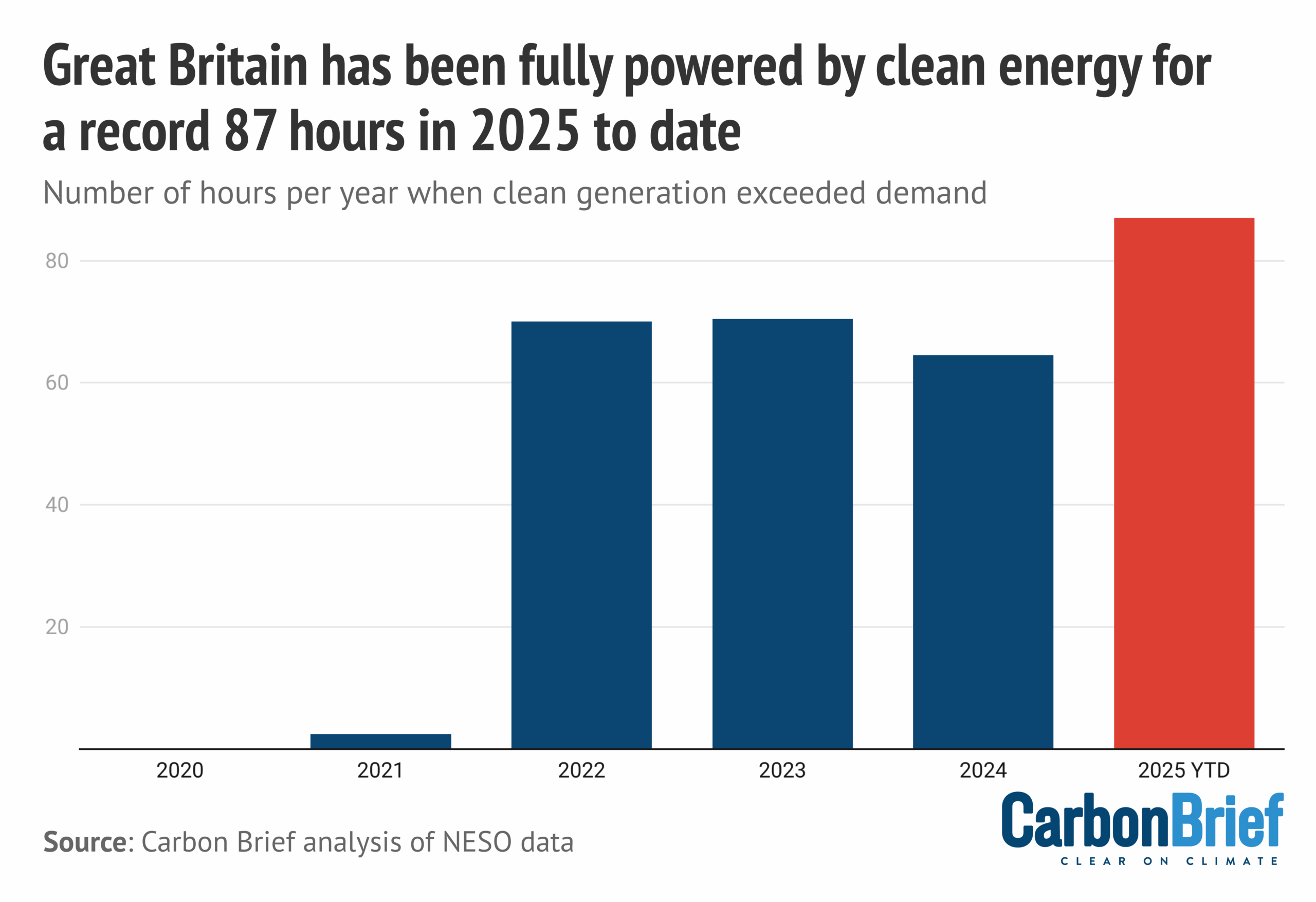
Clean energy has met 100% of Great Britain’s electricity demand for a record 87 hours this year so far, according to new Carbon Brief analysis. This is up from just 2.5 hours in 2021 and 64.5 hours in all of 2024. The longest stretch of time where 100% of electricity demand was met by clean energy stands at 15 hours, from midnight on 25 May 2025 through to 3pm on 26 May, according to the analysis.
Spotlight
‘Overshoot’ unknowns
As the chances of limiting global warming to 1.5C dwindle, there is increasing focus on the prospects for “overshooting” the Paris Agreement target and then bringing temperatures back down by removing CO2 from the atmosphere.
At the first-ever Overshoot Conference in Laxenburg, Austria, Carbon Brief asks experts about the key unknowns around warming “overshoot”.
Sir Prof Jim Skea
Chair of the Intergovernmental Panel on Climate Change (IPCC) and emeritus professor at Imperial College London’s Centre for Environmental Policy
So there are huge knowledge gaps around overshoot and carbon dioxide removal (CDR). As it’s very clear from the themes of this conference, we don’t altogether understand how the Earth would react in taking CO2 out of the atmosphere.
We don’t understand the nature of the irreversibilities and we don’t understand the effectiveness of CDR techniques, which might themselves be influenced by the level of global warming, plus all the equity and sustainability issues surrounding using CDR techniques.
Prof Kristie Ebi
Professor at the University of Washington’s Center for Health and the Global Environment
There are all kinds of questions about adaptation and how to approach effective adaptation. At the moment, adaptation is primarily assuming a continual increase in global mean surface temperature. If there is going to be a peak – and of course, we don’t know what that peak is – then how do you start planning? Do you change your planning?
There are places, for instance when thinking about hard infrastructure, [where overshoot] may result in a change in your plan – because as you come down the backside, maybe the need would be less. For example, when building a bridge taller. And when implementing early warning systems, how do you take into account that there will be a peak and ultimately a decline? There is almost no work in that. I would say that’s one of the critical unknowns.
Dr James Fletcher
Former minister for public service, sustainable development, energy, science and technology for Saint Lucia and negotiator at COP21 in Paris.
The key unknown is where we’re going to land. At what point will we peak [temperatures] before we start going down and how long will we stay in that overshoot period? That is a scary thing. Yes, there will be overshoot, but at what point will that overshoot peak? Are we peaking at 1.6C, 1.7C, 2.1C?
All of these are scary scenarios for small island developing states – anything above 1.5C is scary. Every fraction of a degree matters to us. Where we peak is very important and how long we stay in this overshoot period is equally important. That’s when you start getting into very serious, irreversible impacts and tipping points.
Prof Oliver Geden
Senior fellow and head of the climate policy and politics research cluster at the German Institute for International and Security Affairs and vice-chair of IPCC Working Group III
[A key unknown] is whether countries are really willing to commit to net-negative trajectories. We are assuming, in science, global pathways going net-negative, with hardly any country saying they want to go there. So maybe it is just an academic thought experiment. So we don’t know yet if [overshoot] is even relevant. It is relevant in the sense that if we do, [the] 1.5C [target] stays on the table. But I think the next phase needs to be that countries – or the UNFCCC as a whole – needs to decide what they want to do.
Prof Lavanya Rajamani
Professor of international environmental law at the University of Oxford
I think there are several scientific unknowns, but I would like to focus on the governance unknowns with respect to overshoot. To me, a key governance unknown is the extent to which our current legal and regulatory architecture – across levels of governance, so domestic, regional and international – will actually be responsive to the needs of an overshoot world and the consequences of actually not having regulatory and governance architectures in place to address overshoot.
Watch, read, listen
FUTURE GAZING: The Financial Times examined a “future where China wins the green race”.
‘JUNK CREDITS’: Climate Home News reported on a “forest carbon megaproject” in Zimbabwe that has allegedly “generated millions of junk credits”.
‘SINK OR SWIM’: An extract from a new book on how the world needs to adapt to climate change, by Dr Susannah Fisher, featured in Backchannel.
Coming up
- 7 October: International Energy Agency (IEA) renewables 2025 report launch
- 8-10 October: World summit of Indigenous peoples and nature, Abu Dhabi, UAE
- 9-15 October: International Union for the Conservation of Nature (IUCN) 2025 congress, Abu Dhabi, UAE
Pick of the jobs
- UK government foreign, commonwealth and development office, senior climate policy adviser | Salary: CA$93,207. Location: Calgary, Canada
- Wellcome Trust, senior research manager, climate and health | Salary: £64,800. Location: London
- Bloomberg, product manager – climate, nature and sustainability regulations | Salary: Unknown. Location: London
DeBriefed is edited by Daisy Dunne. Please send any tips or feedback to debriefed@carbonbrief.org.
This is an online version of Carbon Brief’s weekly DeBriefed email newsletter. Subscribe for free here.
The post DeBriefed 3 October 2025: UK political gap on climate widens; Fossil-fuelled Typhoon Ragasa; ‘Overshoot’ unknowns appeared first on Carbon Brief.
Greenhouse Gases
Q&A: What the ‘controversial’ GWP* methane metric means for farming emissions
A controversial way of measuring how much methane warms the planet has stirred debate in recent years – particularly around assessing the climate impact of livestock farming.
The metric – known as GWP* (global warming potential star) – was designed to more precisely account for the warming impact of short-lived greenhouse gases, such as methane.
No country so far has used GWP* to measure emissions, but New Zealand is currently considering its use.
In June, a group of climate scientists from around the world wrote an open letter advising against this.
They argued that the metric “creates the expectation that current high levels of methane emissions are allowed to continue”.
Climate experts tell Carbon Brief that there is “no strong debate” on the science behind GWP* and that it can accurately assess the global warming effect of methane.
But many experts also firmly caution against its use in national climate targets, believing it could allow countries to prolong high levels of emissions at a time when they should be drastically cut.
Some researchers tell Carbon Brief that GWP* is an “accounting trick” and a “get-out-of-jail-free card for methane emitters”. A 2021 Bloomberg article called the metric “fuzzy methane math”.
Prof Myles Allen, one of the scientists who created GWP*, tells Carbon Brief that the metric is “nothing more” than one way of better understanding the climate impact of different actions as part of efforts to limit warming under the Paris Agreement.
In this Q&A, Carbon Brief explains the science behind GWP*, why the metric is so divisive and the ways in which its use has been considered.
- What is GWP*?
- What are the main controversies around using GWP*?
- Do any countries currently use GWP* to measure methane emissions?
- What do experts think about the use of GWP*?
What is GWP*?
Global warming is caused by a build up of greenhouse gases – mainly from burning fossil fuels – trapping heat in the atmosphere.
Different gases cause differing levels of warming and remain in the atmosphere for varying lengths of time. For example, carbon dioxide (CO2), the main contributor to warming, lingers for centuries, whereas other gases last decades or even millennia.
To account for these variables, scientists use a metric known as global warming potential (GWP), which assesses the warming caused by different gases compared to CO2, which has a GWP of 1.
Using GWP, emissions of other gases are calculated in terms of their “CO2 equivalent” over a given amount of time.
In their reports, the Intergovernmental Panel on Climate Change (IPCC) set out three GWP variants measured over 20 years (GWP20), 100 years (GWP100) and 500 years (GWP500).
GWP100 is the most common approach and is used to calculate emissions under the Paris Agreement.
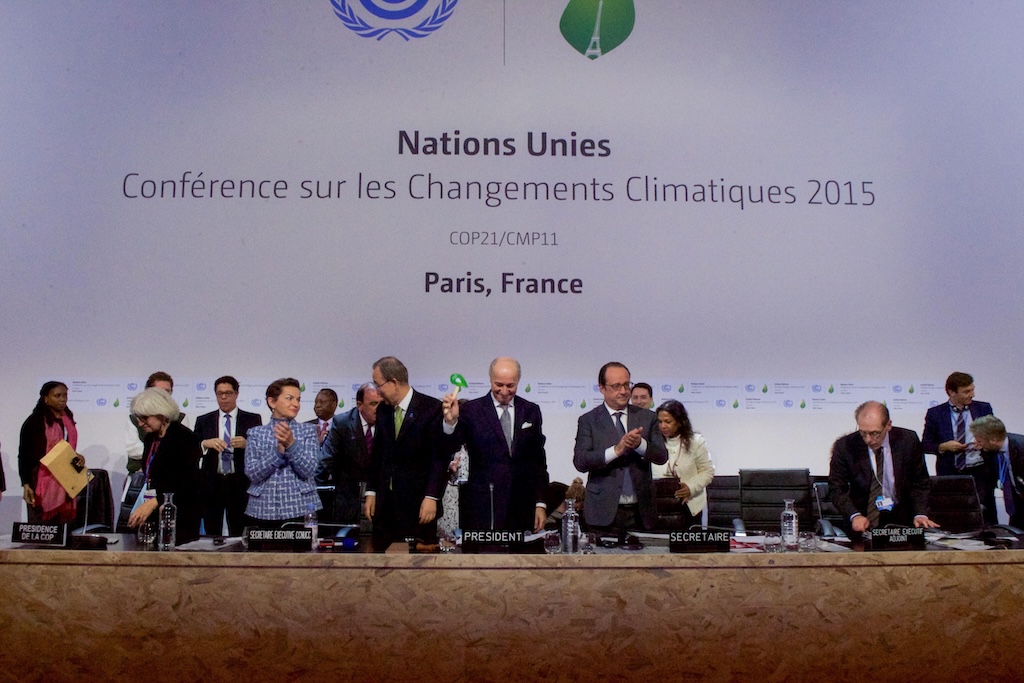
Methane is a short-lived gas that only remains in the atmosphere for around 12 years before breaking down. But it causes a large burst of initial warming that is around 80 times more powerful than CO2, according to the IPCC.
This means that one tonne of methane causes the same amount of warming as around 80 tonnes of CO2, when measured over a period of 20 years.
When calculated over 100 years, methane’s shorter lifetime means it causes around 30 times more warming than CO2.
Some experts have criticised the use of GWP100, saying it does not sufficiently account for the fact that methane leaves the atmosphere much more quickly than CO2 and does not actually last for 100 years. This is the issue that GWP* was designed to fix.
GWP* calculates the warming contributions of long- and short-lived gases at different rates, accounting for their varying lifetimes in the atmosphere.
One of the researchers behind GWP*, Dr Michelle Cain, explained in a 2018 Carbon Brief guest post that a constant rate of methane emissions can maintain stable atmospheric concentrations of the gas, assuming methane sinks remain constant as well.
In contrast, a constant rate of CO2 emissions “leads to year-on-year increases in warming, because the CO2 accumulates in the atmosphere”, Cain wrote. CO2 does not leave the atmosphere after a decade or so, as methane does, and continues to build over time until emissions stop.
Cain, formerly a researcher at the University of Oxford and now a senior lecturer at Cranfield University, added:
“For countries with high methane emissions – due to, say, agriculture – this can make a huge difference to how their progress in emission reductions is judged.”
Methane emissions that slowly decline or remain stable over time are calculated as contributing “no additional warming” to the planet, which is not the case with other GWP calculations.
The chart below shows simplified emissions scenarios for CO2 and methane, highlighting the different impacts they have on global warming over time.
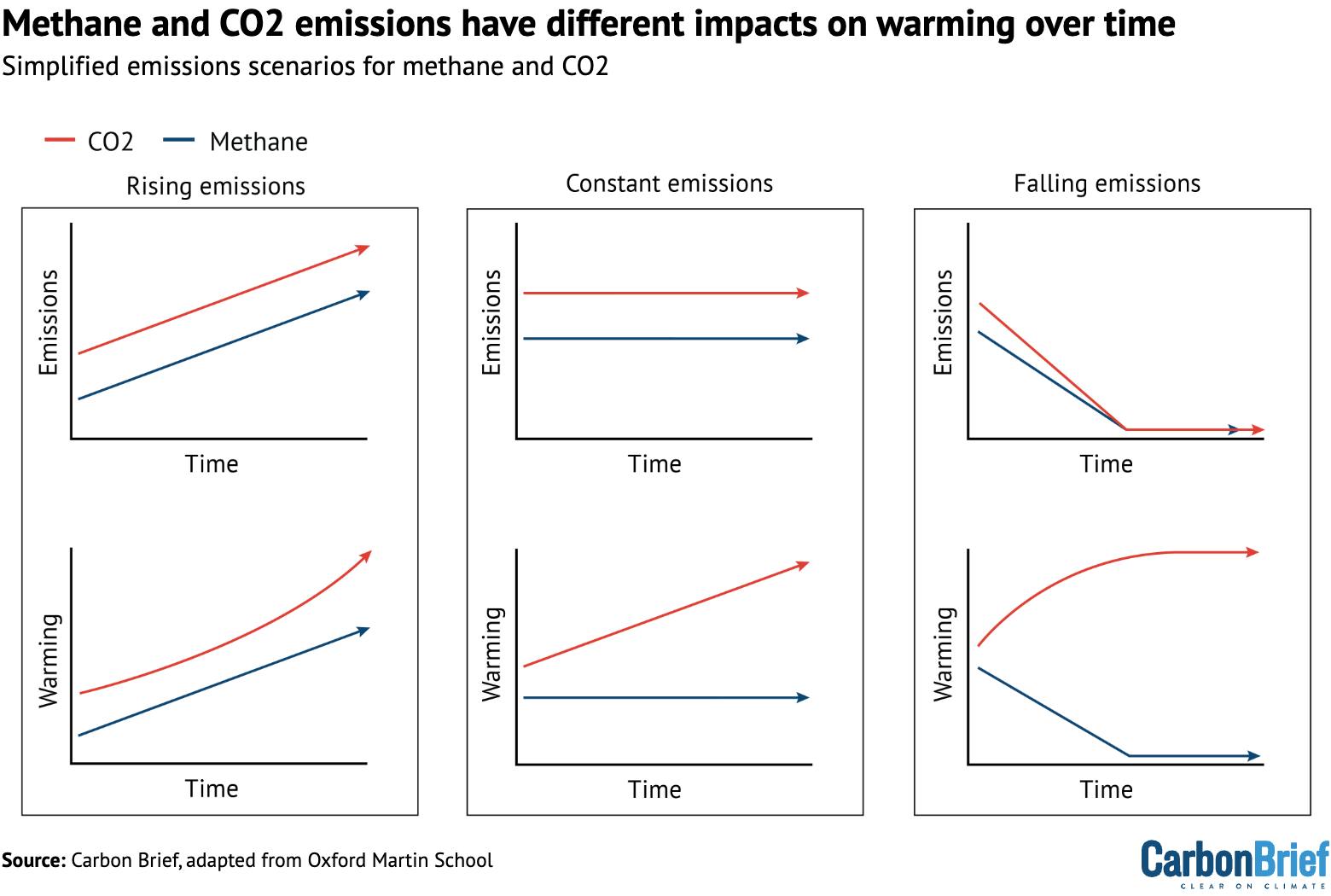
The chart below shows how using the two different metrics – GWP* and GWP100 – affects the same emissions pathway throughout the 21st century, given the different warming impacts of greenhouse gases.

If, for example, a country emitted 4m tonnes of methane annually from 1990-2005, these emissions would now be considered “climate-neutral” using GWP*, as they are not actively contributing new warming to the atmosphere, but rather maintaining the existing levels of methane in the atmosphere in 1990.
This would not be the case under GWP100, which looks at the warming potential of emissions over the course of a century and does not account for their different atmospheric lifetimes.
GWP* can be used for other short-lived gases, such as some hydrofluorocarbons, but methane is the most significant short-lived gas when it comes to climate change.
The IPCC notes that converting methane emissions into CO2 equivalent using GWP100 “overstates the effect of constant methane emissions on global surface temperature by a factor of 3-4” and understates the impact of new methane emissions “by a factor of 4-5 over the 20 years following the introduction of the new source”.
GWP* was created by several researchers, including Prof Myles Allen, the head of atmospheric, oceanic and planetary physics at the University of Oxford. The concept was detailed in a 2016 study and first named in a 2018 study. It was further updated by the authors in 2019 and 2020.
Allen tells Carbon Brief that the researchers involved were “reluctant” to give their new metric a name, as it “was just a way of using reported numbers to calculate warming impact”. He adds:
“I think it’s really unfortunate that people have latched onto GWP*. It doesn’t matter. We could forget about GWP* entirely, we can just use a climate model to work out the warming impact…GWP* is a handy way of calculating the warming impact of activities. Nothing more.”
What are the main controversies around using GWP*?
Efforts to cut methane emissions are widely viewed as a “quick-win” to help limit the effects of climate change in the short term.
More than 100 countries signed a pledge, launched at COP26 in 2021, to cut global methane emissions by 30% by 2030.
Cutting methane would also help to counteract an acceleration in warming due to declining aerosol emissions, which are currently masking around half a degree of warming.
Experts Carbon Brief spoke to agree on the importance of cutting methane emissions, but disagree on whether GWP* helps or hinders these efforts.
The debate around the metric centres on the possible impacts of its use, rather than the soundness of the science behind it.
Prof Joeri Rogelj, a climate science and policy professor at Imperial College London, explains:
“At the global level, at any level, the method of GWP* actually provides a good, new way to translate the trajectory of methane emissions into equivalent emissions of CO2, or emissions of CO2 that would have an equivalent warming effect…The debate is on the application.”
Allen says he is a “little frustrated” that discussions around the use of GWP* have “become so emotive”. He tells Carbon Brief:
“Every action we take has both a temporary impact on global temperature and a permanent one. How much is in both areas depends on the action. We need to know those two things in order to make decisions about choices of action in pursuit of a temperature goal…GWP* gives you a handy way of doing that.”
Below, Carbon Brief details some of the main discussion points and controversies around GWP*.
Carbon cycle
A misleading claim frequently made about livestock is that cows do not contribute much to global warming because the methane they emit eventually returns to the land through the carbon cycle – the set of processes in which carbon is exchanged between the atmosphere, land and ocean, as well as the organisms they contain.
Those in favour of using GWP* to measure methane emissions often also stress the difference between methane emissions that come from animals – known as biogenic methane – and methane from fossil fuels.
Rogelj tells Carbon Brief that biogenic and fossil-sourced methane are “slightly different, but that difference is really second-order” when it comes to climate change.
Methane warms the planet while it is in the atmosphere, so the “climate effect is exactly the same, irrespective of which source the methane comes from”, Rogelj adds.
The differences become more significant when methane breaks down in the atmosphere and oxidises into water vapour and CO2.
CO2 that originated from a cow can be reabsorbed by plants and the land. But the CO2 resulting from fossil methane – which stems from sources such as flaring from oil and gas drilling – stays in the atmosphere. Although fossil methane has a “bit of a longer effect”, Rogelj says:
“This is a bit of a red herring, because the main effect is, of course, the effect that the methane has while it is methane and not what the carbon molecule of that methane has after [the] methane has been broken down or oxidised to CO2.”
He adds that there are ways of reducing agricultural methane, such as “diet change” or “management measures”, but no way to remove the emissions “100%”.
The graphic below shows the digestive process through which a cow emits methane.
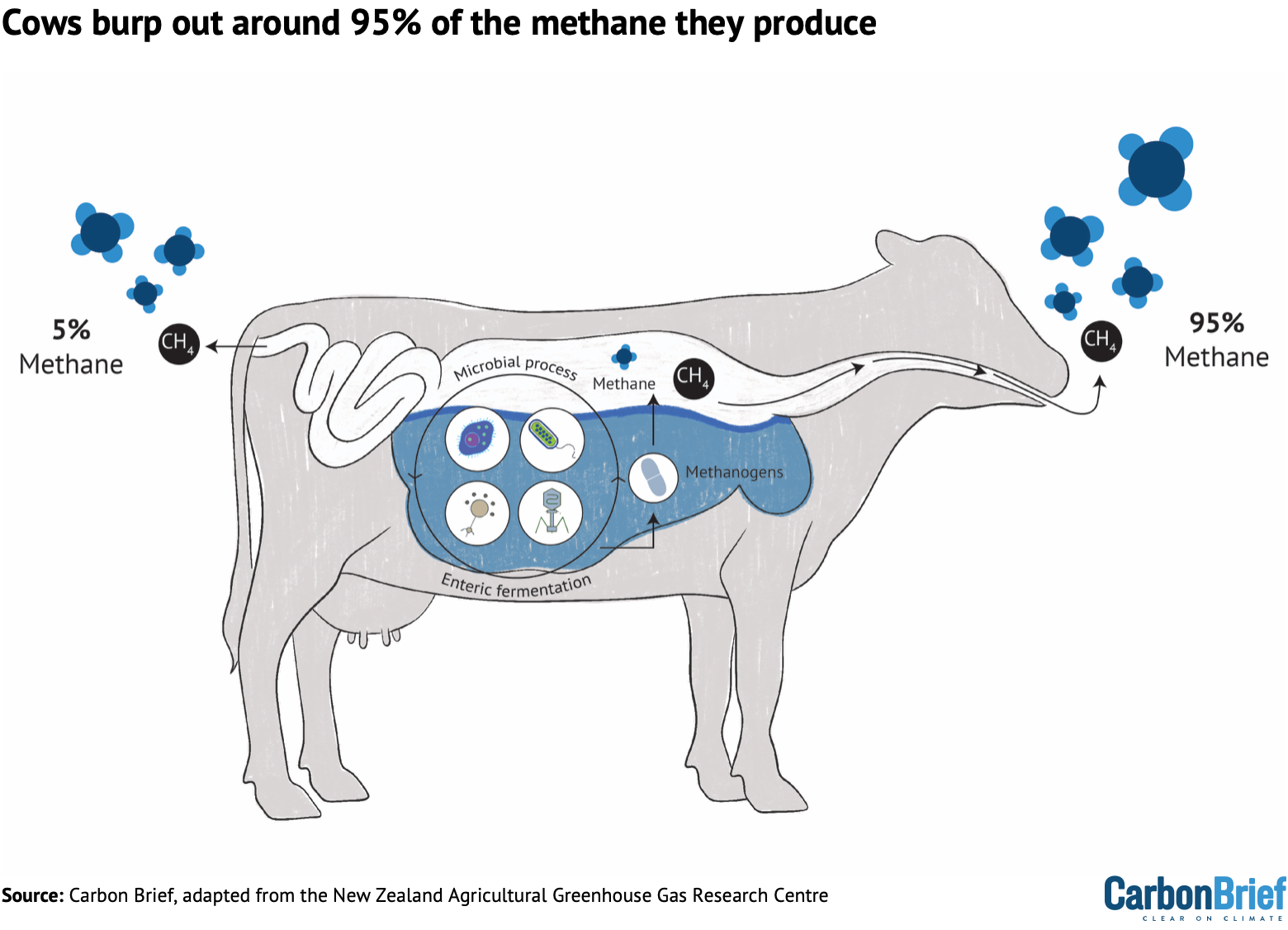
Agriculture also causes other significant environmental harms. It is responsible for around 80% of global deforestation and is a key driver of biodiversity loss and water pollution.
Prof Frank Mitloehner, a professor and air-quality specialist at the University of California, Davis (UC Davis), is one of the main proponents of GWP*, frequently speaking about it in public presentations and discussions with the farming sector.
He tells Carbon Brief that, while animal agriculture can cause environmental harm, it is a “silly argument” to say these impacts are being ignored in carbon-cycle discussions.
He gives an example of discussions on deaths from car accidents excluding mentions of the emissions from cars, saying that these wider impacts are still important and can be discussed separately.
He adds that it is an “urban myth” that biogenic methane emissions are not a concern because of the carbon cycle.
‘No additional warming’
Under GWP*, methane emissions stop causing new warming once they reduce by 10% over the course of 30 years – around 3% each decade, or 0.3% each year.
These emissions are then described in research and policy as causing “no additional warming”.
For example, a 2021 study from Mitloehner and other UC Davis researchers, found that methane emissions from the US cattle industry “have not contributed additional warming since 1986”, based on GWP* calculations. It also said that the dairy industry in California “will approach climate neutrality” by the 2030s, if methane emissions are cut by just 1% annually.
(According to the US Environmental Protection Agency, methane emissions from enteric fermentation – the digestive process through which cows produce the greenhouse gas – increased by more than 5% over 1990-2022.)
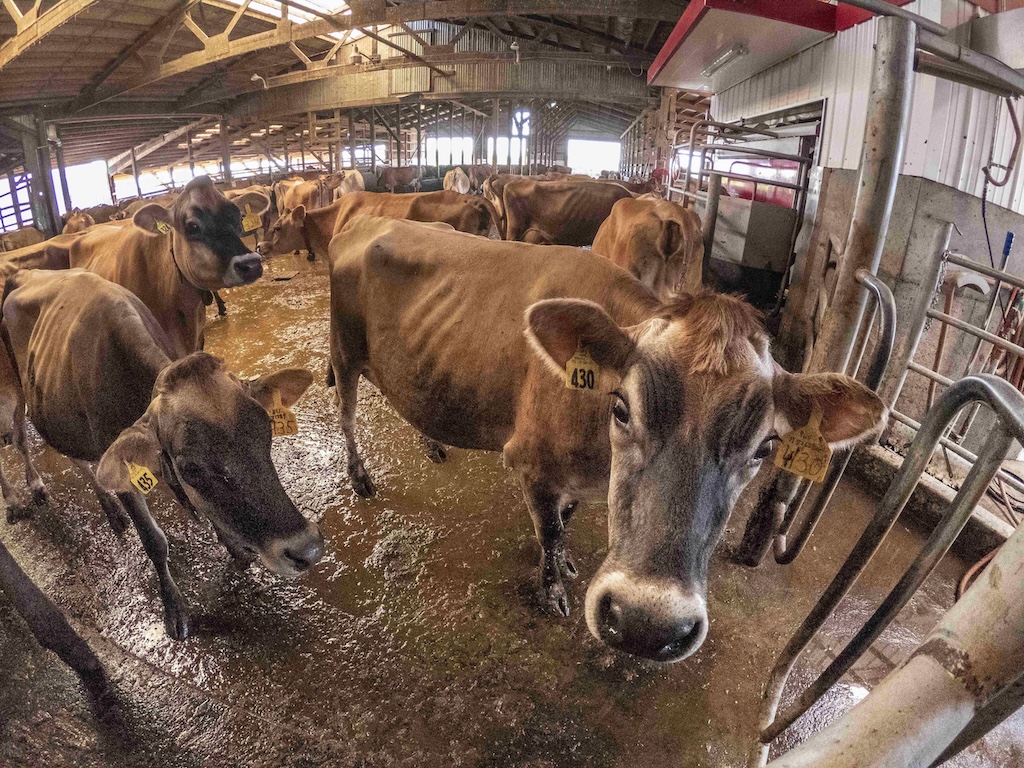
However, many critics take issue with the “no additional warming” concept.
The main criticism is that, although a gradually reducing herd of cattle may stabilise methane emissions, it still emits the polluting gas. If animal numbers were instead drastically reduced, this would cut methane emissions and lower warming rather than maintaining current levels.
Dr Caspar Donnison, a postdoctoral researcher at Lawrence Livermore National Laboratory in the US, says the term no additional warming is “absolutely misleading” in the context of GWP*. He tells Carbon Brief:
“You just assume, on the face of it, that this means it has a neutral impact on the climate…But ‘no additional warming’ means that you’re still sustaining the warming that the herd is causing.”
Allen says that the debate focuses on the “stock of warming versus additional warming”. He compares it to accounting for historical emissions of CO2:
“If a country got rich by burning CO2, they’ve caused a lot of warming in the past. If they reduce their CO2 emissions to zero, then people are generally happy to call what they’re doing climate-neutral, even though they may be sitting on a huge heap of historical warming caused by their CO2 emissions while they were burning [fossil fuels].
“And yet, temperature-wise, that’s exactly the same thing as having a source of methane that’s declining by 3% per decade.”
Climate ambition
Another criticism around the use of GWP* is that countries or companies with high agricultural methane emissions could use the metric to make small emission reductions appear larger.
Dr Donal Murphy-Bokern, an independent agricultural and environmental scientist, believes that the metric can be used as a “get-out-of-jail-free card for methane emitters”. He adds:
“It’s all about saying carry on as we are; we’ll manage this by slightly reducing our emissions over a critical period in history, so as to appear at that critical period in history to be so-called ‘climate-neutral’.”
Mitloehner disagrees with this, noting that, while reductions in methane emissions appear significant under GWP*, increases also appear significant. He says:
“It is simply not true that GWP* is a get-out-of-jail-free card. It’s not. If you reduce emissions, it makes your contributions look less. If you increase emissions, it makes your contributions much worse.”
Rogelj says he has not seen GWP* being used to advocate for the “highest possible ambition” in cutting methane emissions.
However, Allen says that “no metric tells you what to do”. He adds:
“How you measure emissions and how you measure warming has absolutely no bearing on whether you think a country has an obligation to undo some of the damage to the climate they’ve caused in the past.
“This is where the ‘free-pass’ argument makes no sense to me, because the existence of a method to calculate the warming impact of your emissions allows you to make decisions about emissions in light of their warming impact, sure, but it doesn’t tell you what the outcomes of those decisions should be.”
Allen adds that the livestock sector is “unsustainable globally”, with animal numbers and methane levels still rising.
The chart below shows how atmospheric methane concentrations have increased in recent decades.

Allen tells Carbon Brief:
“Do we need to eliminate livestock agriculture to stop global warming? No…[but] we do need to start decreasing it. And if we can decrease it faster than 3% per decade then that would help reduce warming that’s caused by other sectors or, indeed, undo some of the warming that the livestock sector has caused in the past.”
Mitloehner says considerations on the fairness of using GWP* are “real from a policy standpoint and they have to be addressed from a policy standpoint”. He adds:
“But, from a scientific standpoint – and that’s where I’m coming from – I think it’s not controversial.”
Baseline and historical emissions
The baseline year from which emissions reduction targets are set is significant, as it helps form the scope of climate ambition.
For example, high-emitting countries, such as the UK, have set 1990 as their baseline year for emissions-cutting targets, whereas many low-emitting countries may choose further back or more recent years, depending on their needs. Rogelj says:
“Because GWP* translates a change in emissions into either an instantaneous emission or instantaneous removal of CO2, your starting point becomes really important.
“If you start with very high emissions of methane and you did not in any way account for this high starting point, then even very minor, unambitious reductions in methane would result in creating credits for high-polluting countries.”
However, he notes that this is just one way of applying the metric and that there could be ways to avoid this “inequitable outcome”, such as applying GWP* globally and allocating each country a per-capita methane budget, instead of assessing based on national current or past emissions. (Rogelj and Prof Carl-Friedrich Schleussner discussed other possible GWP* equity measures in a 2019 study.)
The chart below, adapted from that study, shows how GWP* can significantly change the per-capita methane emissions of different countries. Some countries with high agricultural methane emissions, such as New Zealand, change from high to low per-capita emitters.
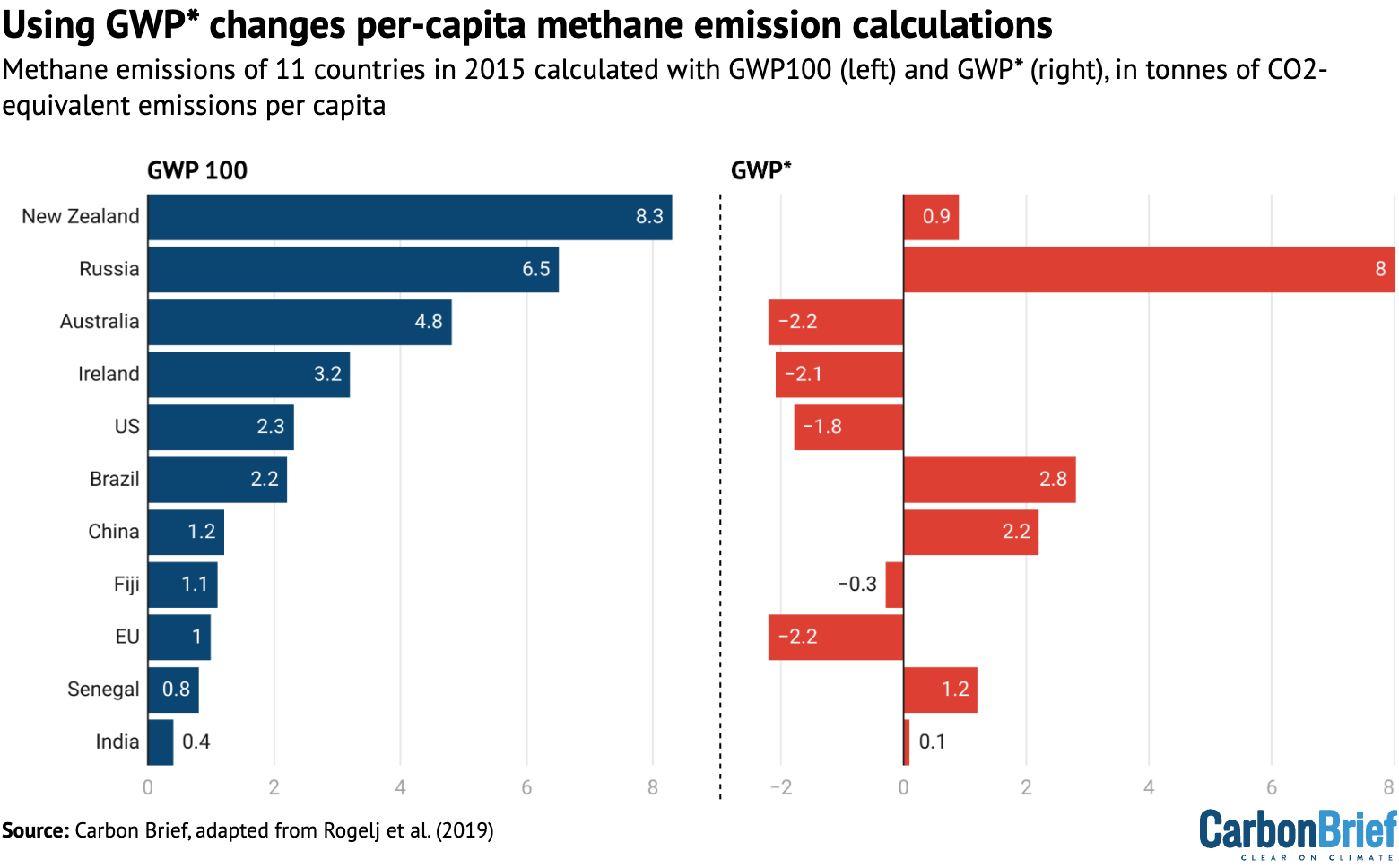
A 2025 study used a climate model to quantify future national warming contributions for Ireland under different emissions scenarios and found that “no additional warming” approaches, such as GWP*, are “not a robust basis for fair and effective national climate policy”.
Discussing baseline concerns, Allen says these considerations are the same for any other metric:
“It depends on how much account you want to take of [the] warming you’ve caused in the past – and at what point you want to take responsibility for the warming your actions had caused.”
He believes that most climate experts agree that it is good to understand the impact emissions have on global temperatures, but “where the controversy arises is about what you consider someone’s nominal emissions to be today”. He adds:
“This is where everybody gets upset, because if you use GWP*, then a livestock sector that’s reducing its emissions by 3% per decade – which most global-north livestock sectors are doing – it looks like their emissions are quite small.
“But that’s only a problem if you think that the main issue is working out whose fault global warming is, rather than working out what we should do about it.”
Communication
Many experts Carbon Brief spoke to took issue with how GWP* has been discussed by some of its proponents.
Murphy-Bokern criticises how Mitloehner and other experts communicate the metric. He says:
“The confusion arises from the activities of Mitloehner, in particular, where he presents the farming community – and the industry in general – with the idea that you can magic away the warming effect of methane simply by looking at the rate of change of methane emissions.”
Mitloehner says he has no regrets about his communication of GWP*, adding that he has “always emphasised to the livestock sector that reductions of methane are important”. He tells Carbon Brief:
“I’m proud because I have been able to take the livestock sector along with the understanding that reductions are needed and that they can be part of a solution if they understand that.”
The New York Times reported in 2022 that the research centre led by Mitloehner at the University of California, Davis “receives almost all its funding from industry donations and coordinates with a major livestock lobby group on messaging campaigns”. Other reports note his discussions about GWP* with stakeholders in various countries.
In response to these reports, Mitloehner says he believes it is important to work with the sector you are researching, adding that he receives both public and private funding. He tells Carbon Brief:
“The problem is not that they [the meat industry] are investing in research and communications and extension. The problem is that they are not putting in enough, because the public sector is withdrawing from this.
“Climate research is being slashed…If the government is not paying into research to quantify and reduce emissions – and those people who are critical of what we do say ‘oh, industry shouldn’t do it’ – then, I ask you, who should?”
Colin Woodall, the chief executive of the National Cattlemen’s Beef Association, a US lobby group, said in 2022 that GWP* is the “methodology we need to make sure everybody is utilising in order to tell the true story of methane”, Unearthed reported. According to the outlet, he added:
“We’re working with our partners around the globe to ensure that everybody is working towards adoption of GWP*.”
Asked if he regrets anything about his communication of GWP*, Allen tells Carbon Brief:
“When we first introduced this – and, perhaps, this is one thing I do regret – I was, perhaps, a little naive in that I thought everybody would seize on focusing on [the] warming impact because it was, from a policy perspective, potentially much easier for the agricultural sector.
“I thought that this would actually be welcomed. But, sadly, it’s not been. And I think part of that is because of this narrative of blame.”
Do any countries currently use GWP* to measure methane emissions?
GWP* is not yet used by any country in methane emission reporting or targets. But it has been considered by New Zealand, Ireland and other nations with high agricultural emissions.
A 2024 statement from dozens of NGOs and environmental organisations called for countries and companies not to use GWP* in their greenhouse gas reporting or to guide their climate mitigation policies. They wrote:
“The risks of GWP* significantly outweigh the benefits.”
New Zealand
New Zealand is currently considering changing its biogenic methane target, including applying the “no additional warming” approach used in GWP*. If it does so, it could become the first country to adopt GWP*.
The nation is a major livestock producer and agriculture generates nearly half of all its greenhouse gas emissions.
The chart below shows that the agricultural sector is also responsible for more than 90% of the country’s methane emissions.
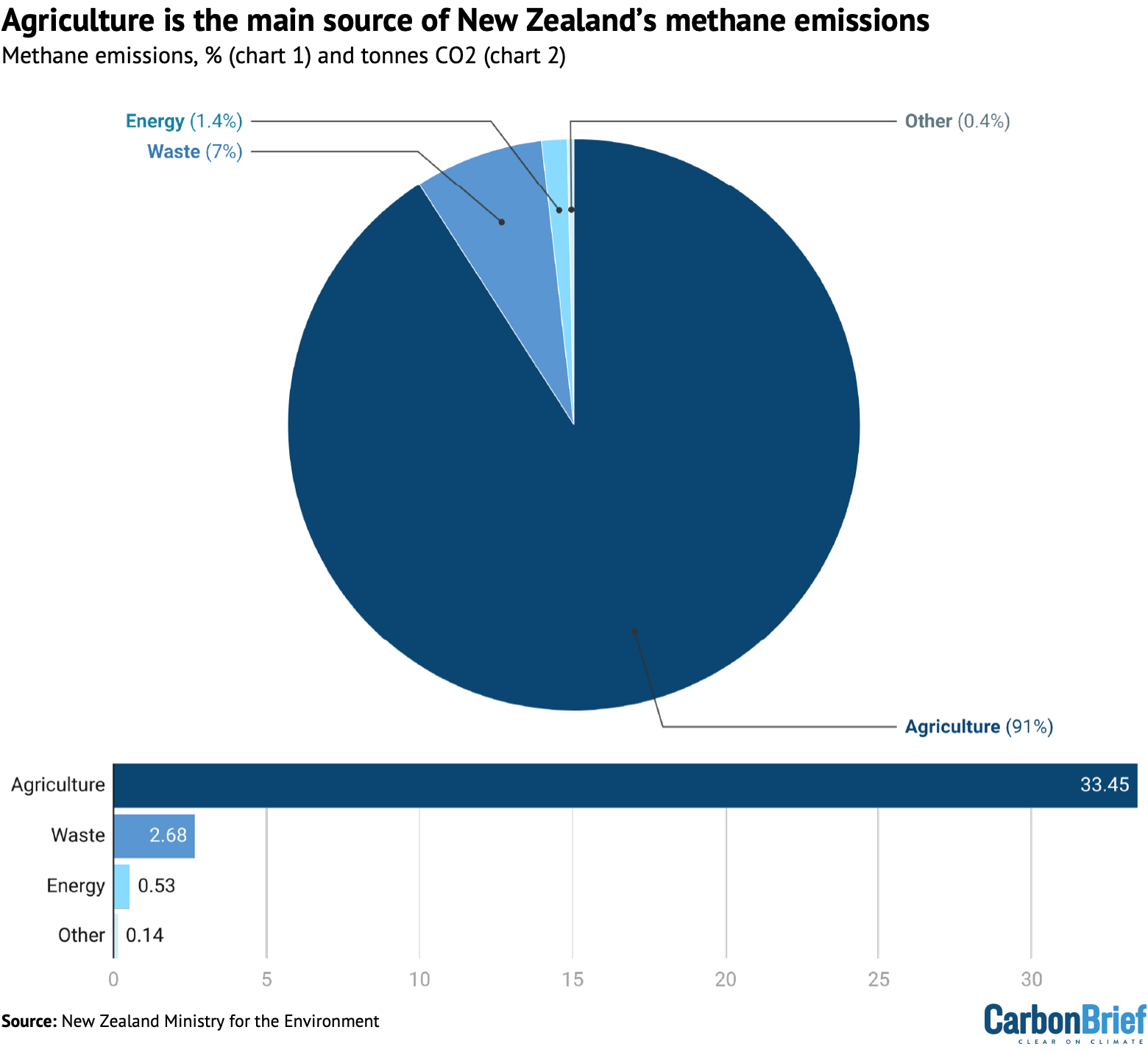
New Zealand has a legally binding target to reach net-zero greenhouse gas emissions by 2050. However, biogenic methane has separate targets to reduce by 10% by 2030 and by 24-47% by 2050, compared to a baseline of 2017 levels.
In late 2024, a review from the nation’s Climate Change Commission recommended that the government change its 2050 greenhouse gas targets, including to increase the biogenic methane goal to a 35-47% reduction by 2050.
At the same time, an independent panel commissioned by the New Zealand government reviewed how the country’s climate targets would look under the “no additional warming” approach.
The resulting report, which did not look specifically at GWP*, but used a similar concept, found that a 14-15% cut in biogenic methane by 2050 would be “consistent with meeting the ‘no additional warming’ condition”, under mid-range global emissions scenarios that keep temperatures below 2C.
The government is “currently considering” these findings, a spokesperson for the Ministry for the Environment tells Carbon Brief in a statement.
The spokesperson says that the report is “part of the body of evidence” that the government will use in its response to the Climate Change Commission’s review, which it must publish by November 2025.
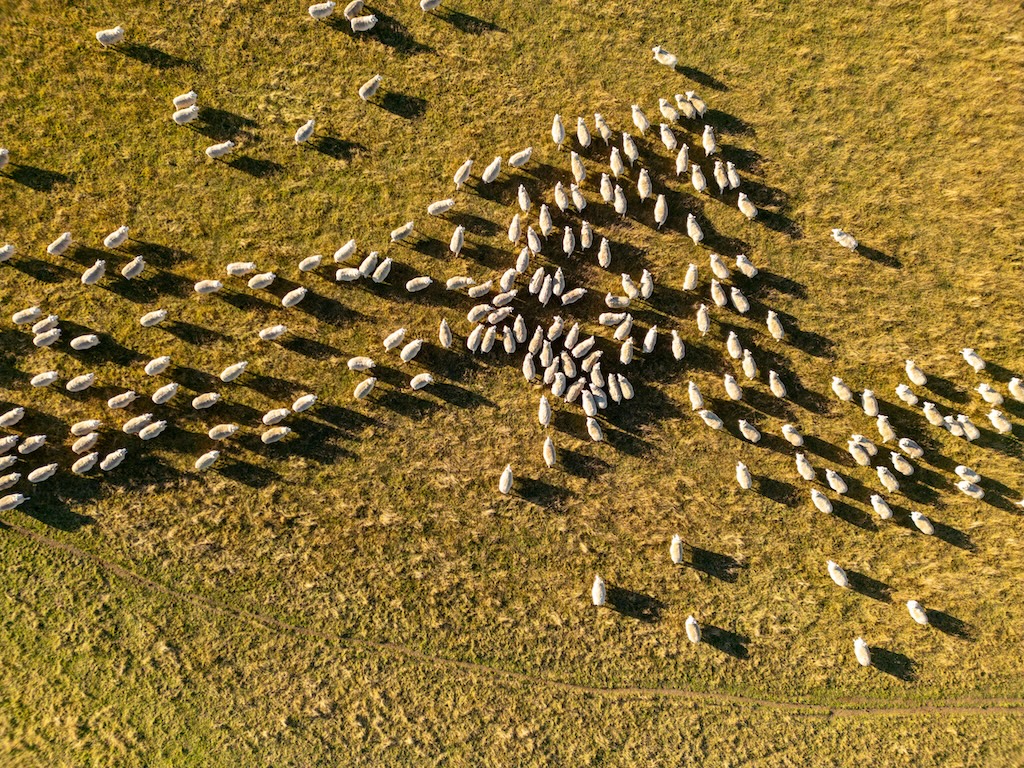
Cain, the Cranfield University lecturer who co-created GWP*, wrote in Climate Home News in 2019 that New Zealand reducing biogenic methane by 24% would “offset the warming impact” of the rest of the country’s emissions, adding:
“New Zealand could declare itself climate-neutral almost immediately, well before 2050 and only because farmers were reducing their methane emissions. That’s a free pass to all the other sectors, courtesy of New Zealand’s farmers.”
A report on GWP* by the Changing Markets Foundation found that, in 2020, 16 industry groups in New Zealand and the UK “urged” the UN’s Intergovernmental Panel on Climate Change to use GWP* to assess warming impacts.
Australia
The Guardian reported in May 2024 that Cattle Australia, a cattle producer trade group, was “lobbying the red-meat sector to ditch its net-zero target in favour of a ‘climate-neutral’ goal that would require far more modest reductions in methane emissions”.
Cattle Australia’s senior adviser and former chief executive, Dr Chris Parker, tells Carbon Brief in a statement that the organisation is “working with the Australian government to ensure methane emissions within the biogenic carbon cycle are appropriately accounted for in our national accounting systems”. He adds:
“We believe GWP* offers a more accurate way of assessing methane’s temporary place in the atmosphere and its impact on the climate. Australian cattle producers are part of the climate solution and we need policy settings to enable them to participate in carbon markets.”
Australia’s Department of Climate Change, Energy, the Environment and Water did not respond to Carbon Brief’s request for comment.
Ireland
Internal documents assessed for the Changing Markets Foundation’s GWP* report “suggest” that Ireland’s Department of Agriculture, Food and the Marine has advocated for GWP* “at the international level”, including at the UN’s COP26 climate summit in 2021.
Allen and Mitloehner were involved in a 2022 Irish parliamentary discussion on methane, in which Allen advocated for the country to “be a policy pioneer” by using GWP* in its methane reporting alongside standard methods.
The country’s coalition government, formed earlier this year, pledged to “recognise the distinct characteristics of biogenic methane” and also “advocate for the accounting of this greenhouse gas to be re-classified at EU and international level”.
A spokesperson for Ireland’s Department of Agriculture, Food and the Marine tells Carbon Brief that this does not refer to using GWP* specifically. They say the country is “in favour of using accurate, scientifically validated and internationally accepted emission measurement metrics”, adding:
“It is important that the nature of how biogenic methane interacts in the environment is accurately reflected in how it is accounted for. This does not mean the use of the metric GWP*.”
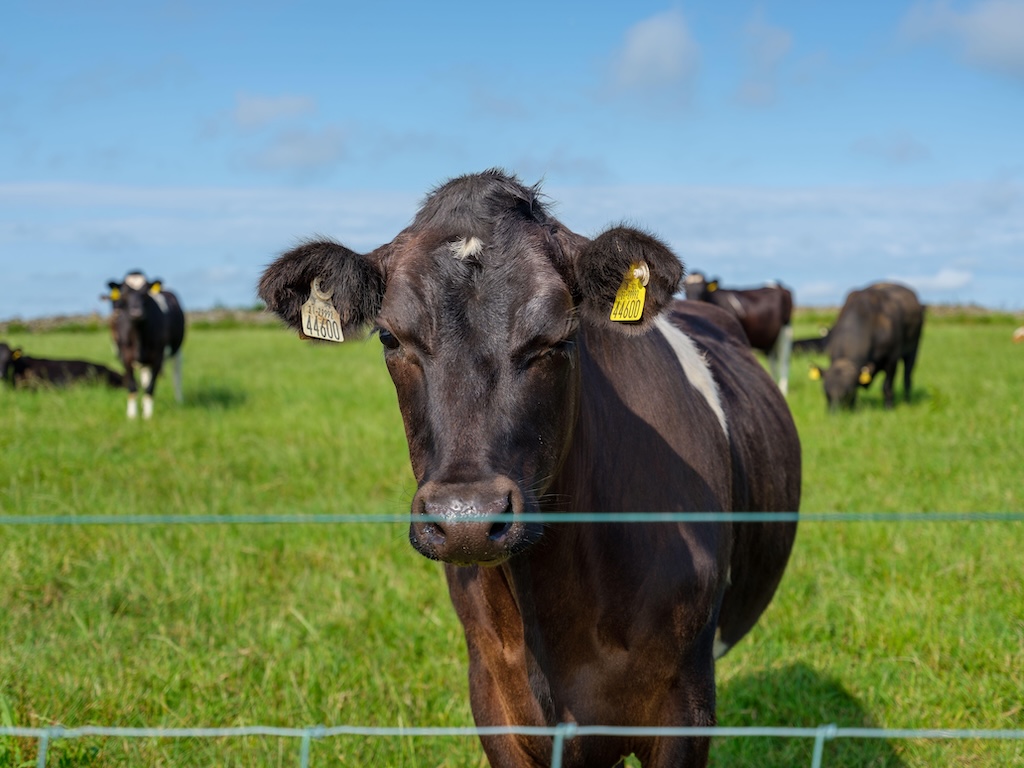
In December 2024, Ireland’s Climate Change Advisory Council proposed temperature neutrality pathway options to the government that do not specifically refer to GWP*, but use the same concept of no “additional warming”.
The Irish Times reported that this was “in part to reduce potential disruption from Ireland’s legal commitment to achieve national ‘climate neutrality’ by 2050”.
The climate and energy minister, Darragh O’Brien, said he has “not formed a definitive view” on this, the newspaper noted, and that expert views will feed into ongoing discussions on the 2031-40 carbon budgets, which are due to be finalised later in 2025.
In an Irish Times opinion article, Prof Hannah Daly from University College Cork, described the temperature neutrality consideration as “one of the most consequential climate decisions this government will make”. She wrote that the approach “amounts to a free pass for continued high emissions” of livestock methane.
Paraguay
Paraguay mentioned GWP* in a national submission to the UN in 2023 after agribusiness representatives “pushed” to adopt the metric, according to Consenso, a Paraguayan online newsletter.
The country’s National Directorate of Climate Change told Consenso for a separate article related to GWP* that it is “aware” of questions around the metric, but that it “has the option of using other measurement systems” for emissions reporting.
UK
The National Farmers’ Union, the main farming representative group in England and Wales, is in favour of using GWP* to measure agricultural methane emissions.
Carbon Brief understands that the UK government is not currently considering using GWP* in addition to, or instead of, GWP100 in its emissions reporting.
What do experts think about the use of GWP*?
Most experts Carbon Brief spoke to agreed that GWP* could be a useful metric to apply to global methane emissions, but that it is difficult to apply equitably in individual countries or sectors. Rogelj believes that are are some contexts in which GWP* could be used, but adds:
“You cannot just take targets that were set and discussed historically with one greenhouse gas metric in mind – GWP100 under the UNFCCC [United Nations Framework on Climate Change] and the Paris Agreement and all that – [and] then simply apply a different metric to it. They change meaning entirely.
“So, if one would like to use GWP*, one should build the policy targets and frameworks from the ground up to take advantage of the strengths of that metric, but also put in place safeguards that ensure that the weaknesses and limitations of that metric do not result in unfair or undesirable outcomes.”
A 2022 study says that using GWP* in climate plans “would ask countries to start from scratch in terms of their political target setting processes”, calling it a “bold ask” for policymakers.
It adds that achieving net-zero emissions, as measured with GWP*, “would only lead to a stabilisation of temperatures at their peak level”.
However, a 2024 study found that GWP* gives a “dynamic” assessment of the warming impact of emissions that “better aligns with temperature goals” than GWP100, when measuring methane emissions from agriculture.
Allen believes that criticism over the use of GWP* is similar to “saying it’s a meaningless question” to consider the warming impact of a country or company’s actions. He adds:
“That seems a very strange position to me, because we need to know how different activities are contributing to global warming because we have a temperature target.
“In saying GWP* is a bad thing, what people are actually saying is it’s a bad thing to know the warming impact of our actions, which is a very strange thing to say.”
He says that such metrics help countries to make informed decisions on climate action, but that “we can’t expect metrics to make these decisions for us”.
Murphy-Bokern notes that GWP* could be useful in modelling global, rather than national, methane emissions to avoid high-emitting countries making small methane cuts to achieve “no additional warming”, rather than significantly reducing these emissions.
He says the metric would be particularly useful if global emissions were close to zero, as a way to target the final remaining emissions. But, he adds:
“We are so far away from that very happy situation, that the discussion now with GWP* is a huge distraction from the key objective, which is to reduce emissions.”
Mitloehner – and every expert Carbon Brief spoke with – agrees with this wider point. He says:
“The main point is we need to reduce emissions. In the case of livestock, we need to reduce methane emissions. And the question is how do we get it done? And how do we quantify the impacts that [that reduction] would have accurately and fairly? The other issues are issues that politicians have to answer.”
The post Q&A: What the ‘controversial’ GWP* methane metric means for farming emissions appeared first on Carbon Brief.
Q&A: What the ‘controversial’ GWP* methane metric means for farming emissions
Greenhouse Gases
EAT-Lancet report: Three key takeaways on climate and diet change
A global shift towards “healthier” diets could cut non-CO2 greenhouse gas emissions, such as methane, from agriculture by 15% by 2050, according to a new report.
The EAT-Lancet Commission report on “healthy, sustainable and just food systems” says this diet would require producing more fruit, vegetables and nuts, as well as fewer livestock.
The findings build on the widely cited 2019 report from the EAT-Lancet Commission – a group of leading experts in nutrition, climate, economics, health, social sciences and agriculture from around the world.
The new report notes that one-third of all greenhouse gas emissions come from the global food system.
These emissions are so great that, even if all fossil fuels were phased out, “food can on its own push us beyond the 1.5C limit”, one of the commission co-chairs, Prof Johan Rockström, told a press briefing.
The report details a “planetary health diet” – a concept first introduced in the 2019 report – which focuses on “plant-rich” and “minimally processed” foods.
The latest edition builds on the previous report by adding improved modelling of food-system transformation and adding social-justice considerations.
The 2019 report faced a “massive online backlash” against some of its findings, particularly on cutting meat consumption, DeSmog reported earlier this year, which was “stoked by a PR firm that represents the meat and dairy sector”.
Rockström said the commission is “ready to meet that assault” if it arises again and issued concern “over this return of mis- and disinformation and denialism on climate science”.
Here, Carbon Brief picks out three key takeaways from the latest report.
- A ‘plant-rich’ diet has the best health and climate outcomes
- Transforming food systems could ‘substantially reduce’ the associated emissions
- Social justice should be a ‘central goal’ in transforming global food systems
A ‘plant-rich’ diet has the best health and climate outcomes
The new report recommends a plant-rich “planetary health diet”, which is largely the same as the one first outlined in the 2019 report.
The diet is designed to be flexible and “compatible with many foods, cultures, dietary patterns, traditions and individual preferences”, the report says.
It does not exclude meat or dairy products – the foods that cause the highest emissions – but recommends limited portions, equating to around one glass of milk per day and a couple of servings of meat and two eggs each week, for those whose diets include them.
The chart below outlines the recommended intake of different foods, adding up to around 2,400 calories each day. A range is given for each food type to accommodate different diets. The categories with the largest intakes include whole grains, plant oils, nuts and legumes.

The diet is “designed for health…[not] sustainability”, Dr Line Gordon, a commissioner on the report, told a press briefing.
But the report also analyses the climate impact of the recommendations. It estimates that shifting to the planetary diet could reduce global non-CO2 agricultural emissions – from greenhouse gases such as methane and nitrous oxide – by 15% by 2050. (See: Transforming food systems could ‘substantially reduce’ the associated emissions.)
Widespread adoption of the diet would require a two-thirds increase in fruit, vegetable and nut production and allow for a one-third reduction in livestock meat production, compared to 2020 levels.
Currently, diets across the globe all “deviate substantially” from the report’s recommendations. But the report claims that, due to the planetary diet’s health benefits, around 15 million “avoidable” deaths could be prevented each year if it were widely adopted.
The report also measures how much global food systems contribute to the nine planetary boundaries – a concept of global thresholds for a “safe and just” planet. It finds that food systems are the largest contributor to five breaches of these boundaries, which include changes in the use of land and freshwater.
In terms of steps to move towards the planetary diet, Gordon listed actions such as changing taxes to make healthy foods more affordable, clearly labelling foods and shifting agricultural production subsidies towards healthier foods.
The report highlights that “transforming food systems is not only possible, it’s essential to securing a safe, just and sustainable future for all”, Rockström says in a statement.
Transforming food systems could ‘substantially reduce’ the associated emissions
Food systems are responsible for about one-third of human-driven greenhouse gas emissions.
These emissions are roughly equally partitioned between livestock and crop production, land-use change and other aspects of the food system, including refrigeration, fertilisers, transport and retail, according to the report.
The authors use global economic models to determine how different actions towards transforming food systems could affect agricultural production, environmental impact and food prices.
For the baseline, they use a set of “business-as-usual” parameters. This scenario uses SSP2-7.0, a high-emissions pathway under which there is a global population of 9.6 billion people and global warming of 2C above pre-industrial temperatures in 2050.
Using these assumptions, the business-as-usual scenario results in a 37% increase in global agricultural production and a 33% rise in non-CO2 agricultural emissions by 2050, compared to 2020. Crop yields increase by nearly one-quarter in this scenario, while the amount of land used for agricultural cultivation expands by 2m square kilometres (km2) – an area roughly the size of Mexico.
The chart below shows the changes in non-CO2 agricultural emissions and agricultural land use under each scenario, with the three main scenarios highlighted in green. The dots indicate the results from different model runs.

The dietary transformation projection assumes a world in which there is total adherence to the suggested diet, a halving of food loss and waste and an additional 7-10% increase in global agricultural productivity.
They find that, in this scenario, agricultural emissions of non-CO2 greenhouse gases decline by 20% compared to 2020 values. Although cropland will have to expand to account for the increased intake of fruits, vegetables and legumes, the decrease in land needed for livestock-rearing means that agricultural land use will fall overall by 3.4m km2, an area the size of India.
The authors also consider a scenario that combines the dietary shifts with “ambitious mitigation” efforts. This includes policies such as carbon pricing and land-use regulations that could drive the adoption of bioenergy, afforestation and renewable energy, the report says.
Under widespread dietary shifts and ambitious mitigation, the report finds that non-CO2 emissions from agriculture will fall by 34% compared to 2020, and the reduction in agricultural land use will double compared to the scenario that only factors in the dietary shifts.
Social justice should be a ‘central goal’ in transforming global food systems
In a step further than its predecessor, the new report assesses justice in global food systems, by analysing the rights to food, a healthy environment and decent work.
The focus on social equity and justice added a “tremendous broader aspect” to the report, Dr Shakuntala Thilsted, one of the commission co-chairs, said in a briefing.
The report notes that more than half of the world’s population struggles to access healthy diets, which leads to “devastating consequences for public health, social equity and the environment”.
This primarily affects marginalised people living in low-income regions, it says.
The report finds that the diets of the world’s richest 30% of the population contribute to more than 70% of environmental pressures from food systems, such as land use and greenhouse gas emissions. The report says:
“These statistics highlight the large inequalities in the distribution of both benefits and burdens of current food systems.”
Furthermore, living and working in toxic-free environments and stable climate conditions is a “crucial” human right, it adds.
According to the report, “power asymmetries and discriminatory social and political structures” – such as the concentration of power among a small number of agribusiness firms – hinder the fulfilment of those rights.
The report says that social justice, along with environmental sustainability, should be central to global food systems.
It proposes several steps to making healthy, sustainable and just food systems more accessible by 2050: securing decent working conditions, ensuring liveable wages, recognising and protecting marginalised groups and limiting market concentration.

It notes that while taking steps to mitigate climate change will increase food costs – particularly in areas that currently do not consume adequate fruits and vegetables, and where animal-sourced food is less commonly eaten – some of these pressures can be alleviated by introducing subsidies targeted towards those preferred food groups.
Finally, the authors underscore that implementing this diet must consider both cultural context and sustainability.
However, they also warn that meeting these goals requires global action and “transformative change” in both individual and cultural habits.
The post EAT-Lancet report: Three key takeaways on climate and diet change appeared first on Carbon Brief.
EAT-Lancet report: Three key takeaways on climate and diet change
-
Climate Change2 years ago
Spanish-language misinformation on renewable energy spreads online, report shows
-
Climate Change Videos2 years ago
The toxic gas flares fuelling Nigeria’s climate change – BBC News
-
Climate Change2 months ago
Guest post: Why China is still building new coal – and when it might stop
-

 Greenhouse Gases1 year ago
Greenhouse Gases1 year ago嘉宾来稿:满足中国增长的用电需求 光伏加储能“比新建煤电更实惠”
-

 Climate Change1 year ago
Climate Change1 year ago嘉宾来稿:满足中国增长的用电需求 光伏加储能“比新建煤电更实惠”
-
Greenhouse Gases2 months ago
Guest post: Why China is still building new coal – and when it might stop
-

 Carbon Footprint1 year ago
Carbon Footprint1 year agoUS SEC’s Climate Disclosure Rules Spur Renewed Interest in Carbon Credits
-
Renewable Energy3 months ago
US Grid Strain, Possible Allete Sale




